For the avid guitar enthusiast or the budding musician on a budget, it’s important to find a high-quality instrument that won’t break the bank.
Locating an acoustic guitar with excellent sound, durability, and playability does not necessarily mean spending an exorbitant amount of money.
Fortunately, the market is packed with many impressive options, providing a selection that caters to everyone from beginners to seasoned performers.
This blog will highlight a variety of popular and highly-rated models, ensuring you get the best value for your money.
We will review each guitar’s unique features, quality of construction, and the overall value it brings to the table.
Stick with us as we unveil these exceptional guitars that merge quality and affordability in perfect harmony.
Table of Contents
- Best Acoustic Guitars Under $2000 That Are Worth Checking Out
- Taylor 317 Grand Pacific Acoustic Guitar
- Martin Road Series SC-13E Acoustic-Electric Guitar
- Guild D-20 Acoustic Guitar
- Yamaha A5M ARE Dreadnought Cutaway Acoustic-Electric Guitar
- Taylor 210ce Dreadnought Acoustic-Electric Guitar
- Martin Guitar D-16E Acoustic-Electric Guitar
- Yamaha AC5M ARE Concert Cutaway Acoustic-Electric Guitar
- Taylor American Dream AD17 Acoustic Guitar
- Epiphone Slash J45 Acoustic-Electric Guitar
- Martin 000-15M Acoustic Guitar
- Taylor Guitars 224ce-K DLX Koa Deluxe Acoustic-Electric Guitar
- Yamaha Red Label FGX5 Acoustic-Electric Guitar
- Takamine EF341SC Legacy Series Acoustic-Electric Guitar
- Fender CD-60SCE Solid Top Dreadnought Acoustic-Electric Guitar
- Takamine EF340S TT Acoustic-Electric Guitar
- Taylor 214ce Deluxe Cutaway Acoustic-Electric Guitar
- Yamaha AC5R ARE Concert Cutaway Acoustic-Electric Guitar
- What Factors to Consider When Buying Acoustic Guitars?
- Does Brand Matter When Purchasing an Acoustic Guitar?
- What Are the Differences in Acoustic Guitar Wood Types?
- Why Should You Consider the Resonance of Acoustic Guitars?
- Does the Neck Shape Affect the Playability of Acoustic Guitars?
- How Does the Guitar Body Shape Affect the Sound Quality?
- Do All Acoustic Guitars Under $2000 Have Inbuilt Tuners?
- How to Properly Maintain an Acoustic Guitar?
- The Bottom Line
Best Acoustic Guitars Under $2000 That Are Worth Checking Out
Before I begin, here are my top selected choices:
|
|
Fender CD-60SCE Solid Top Dreadnought Acoustic-Electric Guitar

Quality Fender guitar with valuable accessories bundle. Check Price
|
Fender CD-60SCE Solid Top Dreadnought Acoustic-Electric Guitar

Quality Fender guitar with valuable accessories bundle.
Check Price
|
Taylor 317 Grand Pacific Acoustic Guitar
Taylor 317 Grand Pacific with exquisite craftsmanship.
This stunning acoustic guitar is made by Taylor and features a Sitka Spruce top, Sapele back and sides, and a Mahogany neck. Built with beautiful Ebony fingerboard and boasting a perfect combination of acrylic, rosewood, and spruce body materials, it offers top-shelf sound quality and playability. With a natural color and impressive dimensions of 47 x 20.5 x 8.5 inches, this instrument is a work of precision and elegance.
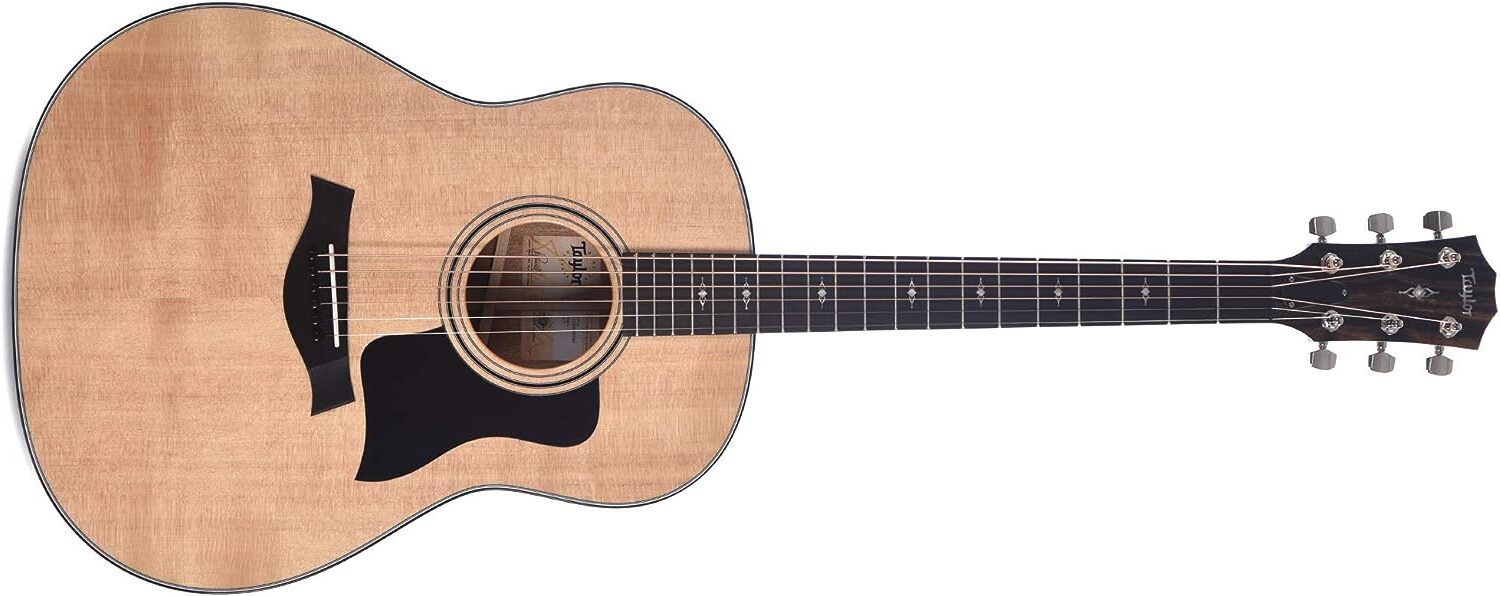
When discussing the noteworthy Taylor 317 Grand Pacific, it’s crucial to mention its unique structural features.
Designed for musicians, it is a 6-string acoustic guitar with an elegant natural finish.
One of its stand-out attributes includes a top meticulously constructed from Sitka spruce.
This guitar’s beauty doesn’t just end at its top, it also boasts a finely-crafted ebony fingerboard.
Complementing these features, the back and sides of the guitar are made from superior-quality Sapele, giving it a distinctive appearance.
A mahogany neck is another attribute that enhances its unparalleled design, ensuring a comfortable grip for the player.
Furthermore, it’s worth noting that the main body of the Taylor 317 Grand Pacific is made from a unique blend of acrylic, rosewood, and spruce materials.
While discussing its overall construction, we should remember the proportions of the guitar, which measure 47 x 20.5 x 8.5 inches.
Being a product of the well-known Taylor brand, you can be certain about the quality of this natural-colored, guitar.
In the world of guitars, the Taylor 317 Grand Pacific with V-Class Bracing stands out not only due to its sound but also its well-thought-out and top-quality materials and design.
- My Review
Let me start by saying that the Taylor 317 Grand Pacific acoustic guitar is a real piece of art.
As soon as I saw the Natural color, I was captivated, yet the real stunner lay within the underlying detail.
Made with a Sitka Spruce top, this guitar delights in supporting you to produce crystal clear sounds.
Emphasizing that, is the touch of majesty that comes with the Ebony fingerboard.
It’s eye-catching yet it does something even more notable by contributing to the overall sound quality and playability.
However, it was when I started to play that I truly appreciated this guitar.
Upon required approach, the V-Class Bracing that this Taylor 317 boasts of, really comes into its own.
To break it down, it enhances the guitar’s volume and sustain, giving you overall control of the tone.
Sapele wood on the back and sides, adds a touch of resonant warmth to the sound.
Topping it off with a Mahogany neck, this guitar ushers in a sense of balance to the tones.
Moving onto the size, weighing in at a sizable 47 x 20.5 x 8.5 inches, this guitar is indeed a full-bodied one.
However, fret not, once you get the hang of it, you’ll hardly notice its size but will instead be immersed in its rich tones.
I found the diverse body material, an interesting mix of acrylic, rosewood, and spruce, extremely impressive as it brings out a distinctive allure and style.
The brand, Taylor, has a reputation for quality, and I can only confirm that the 317 Grand Pacific upholds this reputation.
I must say, the design, materials, and even the craftsmanship are all a testament to what a remarkable guitar this is.
But it’s not just about looks, its sound clarity and volume are remarkable, and the warmth it exudes makes it a treat to play.
Believe me, it’s more than just a guitar, it is a commitment to a great playing experience.
I found the Taylor 317 Grand Pacific a resonant, well-balanced, and truly inspiring instrument that won’t disappoint.
If you ask me, it’s simply irresistible for both its aesthetic appeal and the quality of music it produces.
- Pros:
- Excellent Quality Taylor Brand
- V-Class Bracing for superior sound
- Durable wood construction
- Cons:
- No significant negatives were found.
My final verdict is that the Taylor 317 Grand Pacific with V-Class Bracing is a superb acoustic guitar.
Its exquisite Sitka Spruce Top and Ebony Fingerboard contribute to its superior sound quality.
The combination of acrylic, rosewood and spruce materials in the body construction not only gives an elegant finish but also elevates the instrument’s sustain and tonal clarity.
The V-Class Bracing, a unique feature in Taylor Guitars, enhances the guitar’s volume and projection without sacrificing its signature Taylor tonal clarity.
It is a wonderful instrument and a great value for money for both beginner and skilled guitarists.
Martin Road Series SC-13E Acoustic-Electric Guitar
Exceptional acoustic-electric with Spruce and Ziricote body.
Featuring a spruce top and ziricote fine veneer back and sides, the guitar provides an incredible acoustic-electric performance. The neck is made from select hardwood, matched with an ebony fingerboard for an excellent feel. It includes H-S-S pickup configuration, with nickel strings, suitable for right-hand orientation.
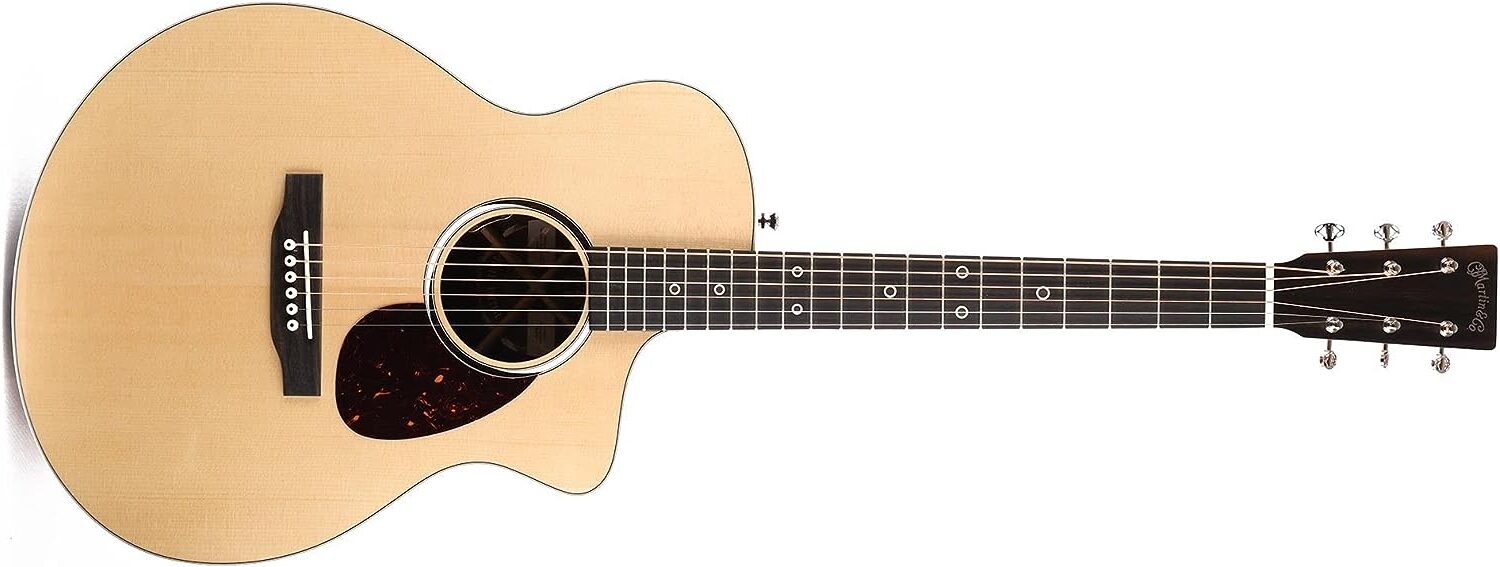
You might have heard about the Martin Road Series SC-13E Special, which comes with an all-natural finish.
It’s a 6-string acoustic-electric guitar, providing a blend of traditional acoustic tones with the convenience of electric performance.
The top surface is made of high-quality spruce, while the back and sides showcase a beautiful Ziricote fine veneer for additional warmth and resonance.
One unique feature is the ebony fingerboard which offers a smooth, swift playing experience, paired with a select hardwood neck believed to be crafted from spruce wood.
This model, produced by the renowned brand Martin, sports a natural color scheme, with the exceptional contrast of Koa and Spruce wood for the top material type.
The body and back material are fashioned from Ziricote, whereas the neck boasts of Spruce wood construction that ensures robustness with a lighter touch.
Furthermore, all of the strings are crafted from Nickel material, promising longevity and a consistent, bright sound.
It should be mentioned that the guitar pickup configuration follows a H-S-S pattern, offering a diverse range of tones and capacities for your playing style.
Significantly, it is designed for right-handed orientation which offers a comfortable hand fit for those players.
Simply put, the Martin Road Series SC-13E Special epitomizes the next stage of acoustic guitar evolution with its remarkable features and high-quality construction.
- My Review
Stepping into the spotlight, I was immediately struck by the stunning natural beauty of the Martin Road Series SC-13E Special.
The 6-string Acoustic-electric guitar speaks volumes with its impressive craftsmanship all over.
Of note, the Spruce Top Ziricote Fine Veneer Back Sides give off a unique look and feel that is indeed eye-catching.
Its sound complemented by the ebony fingerboard, is nothing short of pleasing to the ear and an assurance of quality.
Exploring further into the SC-13E, you’d notice a select hardwood neck, providing a solid durability that elevates the piece beyond the ordinary.
Focusing in on the technical aspects of the guitar, you begin to understand its exceptional nature.
The body and back material is composed of ziricote, a hardwood known for conferring a rich, robust sound to the instrument.
The neck material, on the other hand, is created from spruce wood, a classic choice for stringed instruments due to its balanced tone.
The fretboard, a critical component where your fingers will interact most with the instrument, is made of high-quality ebony wood.
This choice ensures a sleek feel and a tonal quality that will appeal to your musical senses.
Let’s discuss further into the pick-up configuration of this product.
An H-S-S configuration is a commendable feature that gives you a lot of room to shape your sound to your liking.
Additionally, its choice of guitar string material greatly contributes to its overall sound, with nickel being a solid choice for its clear and bright tone.
One thing that could prove to be a factor in your decision is its hand orientation.
Being a right-handed guitar could turn away left-handed guitar enthusiasts unless they’re comfortable with playing it upside down.
No instrument, however, is without its drawbacks.
Try as I may, I was unable to find a single aspect of the Martin Road Series SC-13E Special that I could point out as visibly flawed or lacking.
This isn’t to say it’s a perfect instrument – perfection is subjective, after all – but it certainly does set a high bar.
It’s a robust, beautiful guitar, well deserving of consideration.
- Pros:
- Well-crafted with quality materials.
- Provides professional acoustic sound.
- Featuring modern, attractive design.
- Cons:
- No significant negatives were found.
My final verdict is that the Martin Road Series SC-13E Special Natural is highly recommended for its excellent combination of materials and features.
The acoustic-electric nature provides the versatility that both beginners and professional players would appreciate, with the additional strength and durability from the Ziricote fine veneer back and sides.
Moreover, the ebony fingerboard and select hardwood neck enhance the feel and playability of the guitar, providing an exceptional user experience.
In addition, the unique pickup configuration ensures that a diverse range of tones can be achieved, catering to different musical styles.
For anyone in search of a guitar that combines quality, versatility, and exceptional playability, the Martin Road Series SC-13E Special Natural is worth every penny.
Guild D-20 Acoustic Guitar
Guild D-20 offers powerful warm vintage-toned sound.
This guitar is a US-made model from the reputable brand, Guild, crafted with mahogany top, back, sides and neck, and a rosewood fingerboard. Attributed with a powerful, warm voice, it hits low ends perfectly while maintaining a balance of highs and mid-ranges. Its vintage-style looks, feel, and rich heritage make it an exceptional classic Dreadnought.
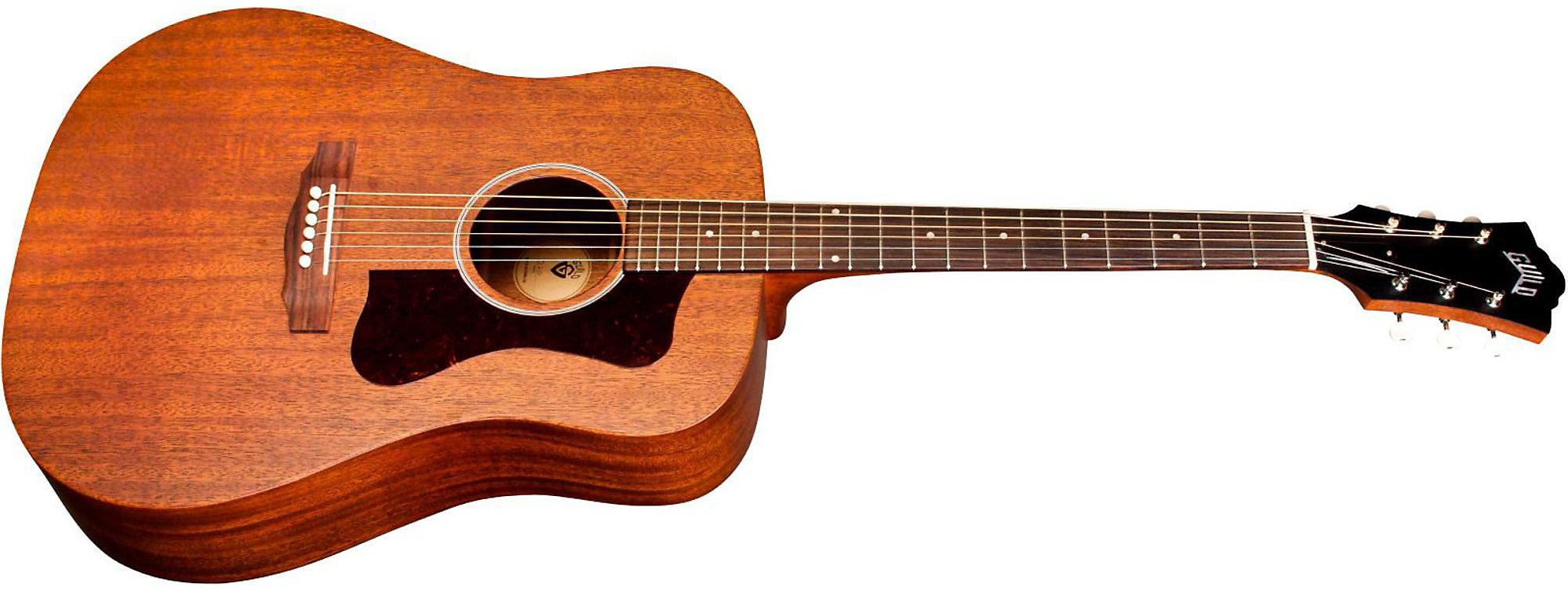
The Guild D-20 guitar, finished in a beautiful natural color, is a six-string acoustic musical instrument.
Created with a Mahogany top and Rosewood fingerboard, it offers a smooth playing experience with a comfortable neck.
Constructed with a Mahogany back and sides, it contributes to the pleasant warmth and balanced tones this guitar produces.
Guild has gracefully remodeled one of their classic dreadnoughts with this particular D-20 guitar, originally first produced in their Rhode Island factory.
For those who appreciate a good balance between highs and mids with a powerful low end, the D-20 guitar might just be what they’re looking for.
Its simple, yet classic style relays a feel reminiscent of vintage guitars, making it both a delight to play and a focal point of discussion.
Detailed workings, like the Mahogany neck and Rosewood fretboard, permeate the guitar’s overall design and it’s clear that this instrument has been carefully constructed, not only to look eye-catching but also to produce the most exceptional sound possible.
This guitar’s dimensions measure 5 inches long, 16.02 inches wide, and 41.77 inches in height, offering a full-sized experience perfect for musicians of all levels but remains especially suited to those who play professional settings.
- My Review
Upon setting my eyes on the Guild D-20, I was immediately drawn to its simple, yet effective, aesthetic.
The natural finish accentuates its Mahogany body, almost bearing a vintage appeal.
What I came to appreciate even more was how it feels in my hands; the Mahogany neck and rosewood fingerboard translates not only into structural integrity but also provides comfort, making it perfect for long jamming sessions.
Not to overlook the other physical attributes, the rosewood and Mahogany wood material composition on the back, not only provides the guitar with a sturdy feel but also contributes significantly to the generation of intimate, warm tones.
What stands out the most when playing this 6-string acoustic guitar, though, is its sound production.
It possesses a powerful, warm voice, with an impressive balance of highs, mids, and a substantial low end, thus producing a classic all-mahogany resonance.
The overall craftsmanship is quite commendable, particularly when you take into account the hand-fitted dovetail neck joint.
Appreciatively, this traditional method of construction results in the more resonant tone of the guitar, a special highlight worth noting.
Contrarily, certain factors did left a slightly sour taste to my overall experience.
The deceptive representation of the Guild D-20’s color and finish, which appeared darker than portrayed in the online images, did leave me somewhat disappointed.
The treatment of the wood had a too heavily dyed effect that seemingly overshadowed the inherent depth and richness that would naturally come from mahogany.
Nevertheless, despite this downside, I felt pretty satisfied with the sound quality of the strings and the exquisite tonal balance that this guitar offers.
I found the Guild D-20 to be a fine piece of musical instrument made in the USA, notable for its superb construction, strong materiality, and unique sound.
Whether you are a professional aiming for studio work or a casual player looking to make some beautiful noise, this acoustic guitar will certainly have you covered.
The durable build, ease of play, and distinctive sound set it apart in its price range, making it a worthy consideration for guitar enthusiasts and professional musicians alike.
When it comes to the Guild D-20, every strum and note tells a tale of legacy, craftsmanship, and passionate music-making.
- Pros:
- Great for finger picking.
- Excellent craftsmanship.
- Powerful, balanced and warm tone.
- Cons:
- Color difference from online pictures.
- Does not travel well.
- Lacks expected depth and richness of sound.
My final verdict is that the Guild D-20 – Natural is an exceptional guitar.
The sound quality is superb, thanks to the mahogany body and rosewood fingerboard.
I especially admired its vintage-style looks and how it evokes a sense of nostalgia, perfectly capturing the spirit of the original Guild’s line.
It is a powerful and warm guitar, ideal for both beginners and seasoned musicians.
If you appreciate top-quality craftsmanship and beautiful, rich tones, the Guild D-20 – Natural is certainly worth considering.
Yamaha A5M ARE Dreadnought Cutaway Acoustic-Electric Guitar
High-quality Japanese acoustic with vintage vibe.
This acoustic-electric guitar boasts a solid Sitka spruce top and mahogany back, sides, and neck. With its vintage natural color, it offers the SRT2 Electronics and an ebony fingerboard. Crafted by Yamaha, it’s designed for right-handed players and features a scale length of 25.5 inches.
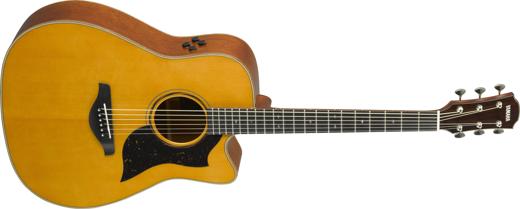
This is the Yamaha A5 Meters ARE Dreadnought Cutaway in Vintage Natural.
It’s a 6-string acoustic-electric guitar that promises an impressive performance.
The guitar impresses its users with a top made of solid Sitka spruce, which blends perfectly with its vintage natural color.
The guitar is also fitted with SRT2 Electronics which enhances its output and performance.
With a back and sides made from solid mahogany, this guitar is as durable as it is aesthetically pleasing.
A fingerboard made of ebony is another feature that stands out about this guitar.
The neck is made from high-quality mahogany, ensuring a strong and resilient make.
This guitar comes from the reputable brand of Yamaha, making it a preferred choice among musicians.
The color of this guitar is vintage natural, adding an air of classic retro charm.
You’ll find that the body, back, and neck materials are all made of mahogany, making for a uniform, well-coordinated look.
The fretboard is ebony wood, fitting in beautifully with the guitar’s overall scenery.
Furthermore, the strings are made from robust bronze, a surety of their durability and functionality.
This guitar is designed for right-handed players.
The scale length of this guitar is 25.5 inches, a common and comfortable standard for most musicians.
Finally, this is a Japanese Acoustic-electric with a vintage vibe and big voice that would surely entice any guitar enthusiast.
- My Review
When I first laid my hands on the Yamaha A5 Meters ARE Dreadnought Cutaway, in its stunning Vintage Natural color, I was immediately drawn to its aesthetic appeal.
The beautiful shade of Vintage Natural, combined with the impeccable design, subtly reaffirms Yamaha’s reputation for crafting visually captivating musical instruments.
What truly stands out about this guitar, however, is the high quality of materials used in its construction.
All elements of its body are crafted from fine Spruce and Mahogany wood, materials that are known for their excellent acoustic qualities.
The solid Sitka Spruce top combined with the solid Mahogany on the back and sides, allow for an impeccably smooth and rich sound experience.
Adding on to that, the Mahogany neck and Ebony fingerboard not only provide a comfortable grip but also contribute to the crisp tonal output of the instrument.
The integration of the SRT2 Electronics is no short of a masterstroke by the brand.
This feature enhances the dynamics of the sound, working magnificently with the Bronze strings, regardless of the genre or style I chose to play.
This acoustic-electric guitar has a scale length of 25.5 inches, which I found to be just the perfect size for both comfort and playability.
Being a right-handed model, it might put left-handed potential buyers in a bit of a pickle, but for me, it was a perfect fit.
In terms of its tones, the solid-top Japanese Acoustic-Electric certainly delivered more than I would expect from a guitar in this price range.
I found the sounds vibrating from the guitar to be warm, resonant and, in all aspects, cultivating a vintage vibe.
Despite the vintage charm, there is a big voice that this instrument carries, making it highly versatile for different musical settings.
However, even with the excellent build and sound quality, some players might find the guitar a bit heavy for their comfort.
The Yamaha A5 Meters ARE Dreadnought Cutaway was an absolute joy to play and discover, producing an infectious sound that had me hooked from the very first strum.
- Pros:
- High-quality Solid Sitka Spruce Top.
- Embedded with SRT2 Electronics.
- Made with solid Mahogany material.
- Cons:
- No significant negatives were found.
My final verdict is that the Yamaha A5 Meters ARE Dreadnought Cutaway – Vintage Natural is a top-quality product.
This acoustic-electric guitar with its solid Sitka Spruce top and Mahogany back exudes not only spectacular aesthetics but also a sound quality that is second to none.
The SRT2 electronics provide superb sound-enhancement, whilst the Mahogany neck and Ebony fingerboard ensure a smooth and comfortable playing experience.
If you’re a right-handed musician looking for a guitar with noteworthy sound, excellent build quality, and vintage appeal, I strongly recommend this Yamaha model.
In the realm of acoustic-electric guitars, it sets the benchmark high.
Taylor 210ce Dreadnought Acoustic-Electric Guitar
High-quality Taylor acoustic-electric with ES2 electronics.
This acoustic-electric guitar features a spruce top, layered rosewood back and sides, with a mahogany neck, offering magnificent resonance. With ES2 Electronics, it ensures fantastic sound reproduction in a vibrant natural color. Right-handed players will appreciate the guitar’s rosewood fretboard and its generously proportioned size of 46″L x 20″W x 9″H.
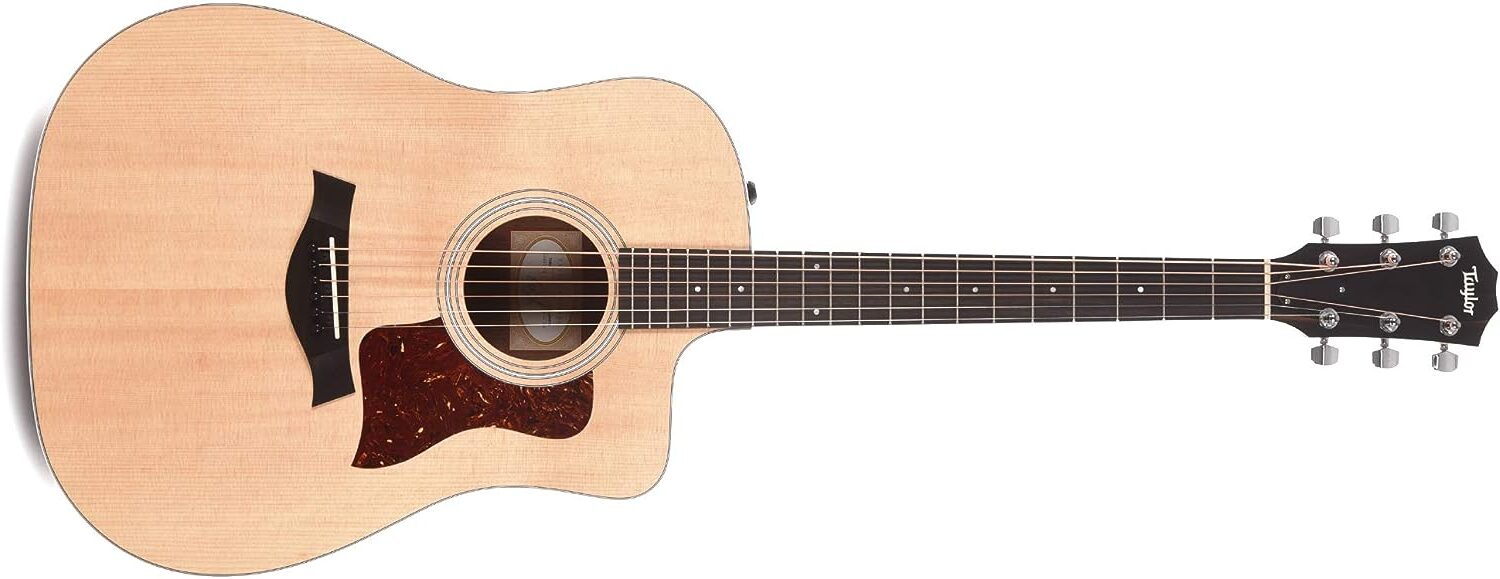
Have a closer look at the Taylor 210ce Dreadnought, a phenomenally designed acoustic-electric cutaway.
It gracefully combines a Sitka spruce top with rosewood back and sides, which suffuses your music with a resonant and full-bodied acoustic flavor.
What stands out about this model is its ES2 electronics, ensuring its sound can carry yards away in its natural, unaltered state.
It is crafted proudly with a rosewood neck, providing you with the ease of playing, and is garnished with an ebony fingerboard, simply to enhance the aesthetics and the musical feel.
Keeping in mind the right-handed majority, this stringed beauty is made with right-hand orientation and comes with six strings to strum upon.
As for the build, its dimensions measure up to approximately 46″ in length, 20″ wide, and 9″ high.
This musical tool is a stunning product from the house of Taylor, and is nicely polished to give it a natural color.
In fact, the layered structure of this piece marvelously combines different wood types like spruce, mahogany, and rosewood that give it an extraordinary feel and appearance.
You would do well to know that the prodigious top is made from Spruce wood, while the body, neck material, and fretboard are all finished in a fine rosewood.
- My Review
Upon playing the Taylor 210ce Dreadnought Sitka/Rosewood Natural ES2, there was an immediate clarity and richness that resonated from the spruce top and rosewood body.
The Ebony fingerboard felt smooth under my fingertips, and the Mahogany neck was perfectly crafted to fit comfortably in my grasp as I navigated the chord progressions of my favorite songs.
Whether played acoustically or connected to an amplifier through the integrated ES2 electronics, I was pleased by the variety of sounds I could achieve with this guitar.
Not just confined to strumming chords, I tried my hand at playing lead lines and was satisfied with the guitar’s handling.
Yet, it must be noted that for more complex, string-bending solos, I did notice some limitation in its capabilities, heightening the emphasis on the instrument’s natural tilt towards rhythm playing.
It was a pleasant surprise that this guitar demonstrated a pleasing leaning towards the lower tones, a trait I found perfect for blues and jazz expression in a recording setting.
Unsurprisingly, part of the charm of this Taylor instrument lies in its design – the Natural Rosewood construction exudes a degree of sophistication and warmth that accompanies the rich tones produced by it.
My personal experience with this guitar has been largely positive, and it quickly became my go-to instrument due to its reliable performance and captivating sound.
The spectacular craftsmanship demonstrated in my Taylor 210ce guarantees that any player will be hard-pressed to outgrow this instrument’s potential, as it caters for beginners as well as skilled guitarists aiming to further their musical repertoire.
The appeal of this beautifully made guitar doesn’t stop at its sound – the allure of its aesthetic keeps me coming back day after day, keen to pick it up and play.
Though the quality of the gig bag was more than satisfactory, I did find myself wishing this magnificent instrument had come with a harder case to provide the level of protection it certainly deserves.
Bearing a Taylor signature definitely adds a special charm to this guitar model, but its outstanding performance stands on its own, distinguishing it as a truly exceptional instrument, regardless of its brand.
Ultimately, the Taylor 210ce Dreadnought Sitka/Rosewood Natural ES2 left an indelible impression on me, offering the kind of musical versatility and outstanding craftsmanship that rival many other guitars in its class.
- Pros:
- Exceptional build quality.
- Great tonal range.
- Suitable for beginners and advanced players.
- Cons:
- Not ideal for leads and bends.
- Gig bag instead of hard shell case.
- May tempt additional purchases.
My final verdict is that the Taylor 210ce Dreadnought Sitka/Rosewood Natural ES2 is a superior quality instrument both in construction and sound.
With its rosewood body and ebony fingerboard, it assures a warm tone and ease of playability ideal for any musician.
Not to mention, the ES2 Electronics allows for amplified play without compromising the acoustic qualities of the guitar.
Given the attention to detail with the beautiful design and the quality of materials used, this guitar provides great value for its cost.
It’s an excellent choice for both beginning and advanced players.
Martin Guitar D-16E Acoustic-Electric Guitar
Handcrafted guitar delivering professional sound and playability.
This acoustic-electric guitar, handmade with highest-quality wood, delivers a professional deep and clear sound with crisp overtones. It combines superior aesthetics and playability with an East Indian rosewood construction, Sitka spruce gloss top, and low oval neck shape. Being part of Martin’s 16 series, its quality, craftsmanship and unmatched tones make it an ideal choice for professional musicians.
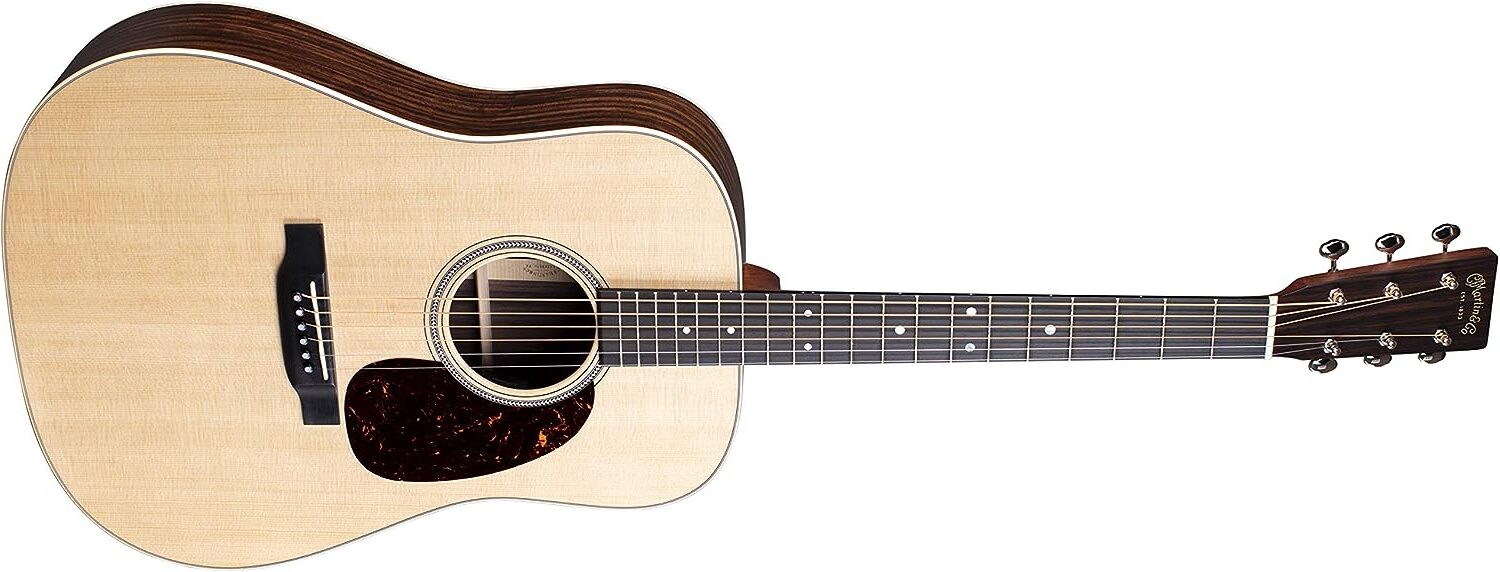
The Martin D-16E Rosewood acoustic-electric guitar is skillfully constructed with East Indian rosewood and Sitka spruce materials, offering a deep, distinct sound enriched with precise overtones and superior projection.
Its dreadnought body style lends a robust bass that beautifully enhances its solid-wood acoustic makeup.
Boasting a captivating aesthetic, the D-16E features a glossed Sitka spruce top and satin-finished East Indian rosewood back and sides.
It includes a simple dovetail neck joint, scalloped forward-shifting X-Brace, high-performance tapered neck, and open nickel tuners, combining elegance and functionality.
Made from the finest quality of wood, Martin’s 16 Series guitars, including the D-16E, are built to withstand extensive use, making them a perfect companion for lengthy jam sessions, performances, or studio recording.
Aside from the iconic Martin tone, the D-16E Rosewood guitar provides a comfortable playing experience, catering to all skill levels and various music genres, from rock and country to jazz and folk.
Among Martin’s renowned guitar and string products, the 16 Series holds its mark as the musicians’ top choice for its unparalleled craftsmanship, quality, and tone.
Also notable is the guitar’s hand orientation that caters to right-handed players, as well as its substantial 25.4-inch scale length.
This magnificent piece of musical instrument is truly an epitome of Martin’s superior quality, with its reputation still holding the standard for handmade, authentic guitars.
- My Review
Upon first hold, the allure of the Martin D-16E Rosewood acoustic-electric guitar is undeniably profound; its finish of Sitka spruce and East Indian rosewood partners traditional craftsmanship with elegance.
Coalescing the appeal of its physical attributes, an East Indian rosewood back and sides bear a satin finish evoking refined aesthetics.
The Burden has been laid on its gloss-top finish to complement rosewood’s natural character, and it proves successful in totally defining the guitar’s invite.
Put the guitar to the test, and the ensuing output of tones and overtones proves a mesmerizing reminder of Martin’s esteemed sound profile.
From the yielding, deep bass supplied by the dreadnought shape to the guitar’s clear sound, this is a guitar that enthralls every sense.
Solidifying the experience, the low oval neck shape further facilitates the pleasure of playing.
Undeniably, the Mitch of intricate tones comes easily and organically, making it a natural fit regardless of music genre – rock, country, folk, bluegrass, or jazz.
However, one should be cautioned that the Martin D-16E Rosewood may not provide the loudest of sounds, but it is an entity that values quality over quantity of sound.
It seems to encourage a softer touch, coaxing out its best when not subjected to heavy strumming, and potentially rock musicians who prefer strumming may not find this the optimal choice.
Yet, there is the realization that this subtlety is not a weakness, but rather a conscious design direction, tailor-made for musicians who appreciate the nuances in acoustic expressions, like finger picking and solos.
And so, if your preferences lay within the realm of softer playing styles, or if you are willing to adapt your playing mannerisms, the Martin D-16E Rosewood certainly validates its premium price with its blend of rich features.
Make no mistake, this isn’t any old guitar; it is a Martin with an unmatched pedigree of top-notch materials, hand-made construction, and designs that have stood the test of time.
In layman’s term, it is decidedly more than just the ‘poor man’s D28’.
The Martin D-16E Rosewood acoustic-electric guitar is not only a delightful musical tool but also a revered piece of art with a heritage that justifies its prestige.
- Pros:
- Professional sound quality.
- Premium handmade construction.
- Suitable for various music styles.
- Cons:
- Potential neck adaptability issues.
- May not be suitable for heavy strumming.
- Possibility of neck warping.
My final verdict is that the Martin Guitar D-16E Rosewood is an exceptional choice for both professional and amateur guitarists.
The superior sound quality and enhanced playability make this guitar suitable for a wide variety of music genres including rock, country, folk, bluegrass, and jazz.
I am particularly impressed by its premium handmade design, which contributes to the instrument’s overall durability and aesthetic appeal.
Moreover, the versatile body styles and sizes in the Martin 16 Series ensures that there is a perfect model for every type of musician.
Believers in quality should consider this exceptional acoustic-electric guitar a worthy investment.
Yamaha AC5M ARE Concert Cutaway Acoustic-Electric Guitar
Solid-top guitar with vintage vibe, big voice.
This guitar comes in a Vintage Natural color, with key components being made from mahogany and Spruce wood. Boasting of a 6-string Piezo pickup configuration and solid Sitka Spruce top, it offers a fantastic musical experience. With its right-hand orientation and a unique Vintage vibe, it offers an unparalleled acoustic-electric experience.
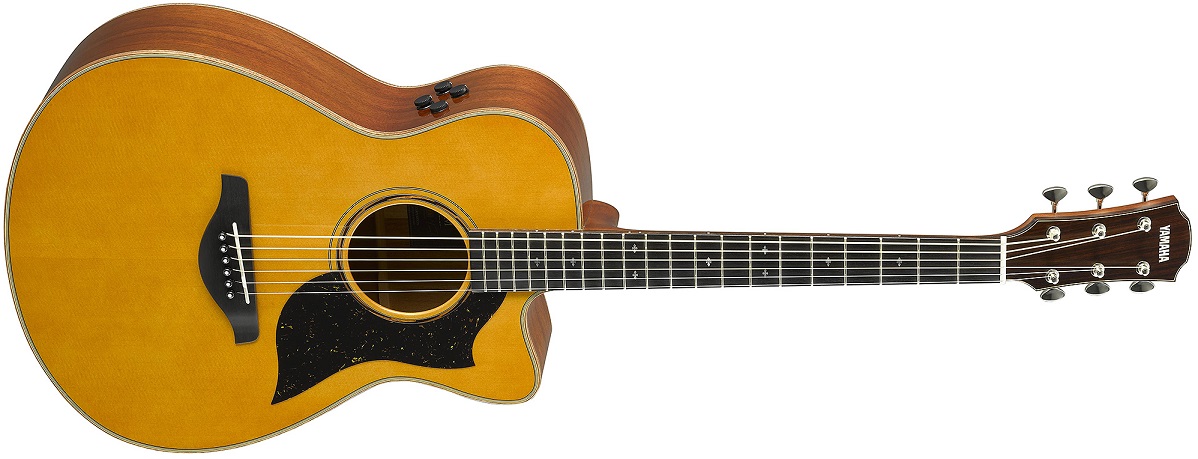
This is a cutaway acoustic-electric guitar from the well-known Yamaha brand, specifically the AC5M ARE Concert model. This guitar has an attractive, warm Vintage Natural color.
One of the standout features of this guitar is the solid Sitka spruce top. The spruce wood gives it a beautiful sheen and the solid construction means it’s built to last.
The body and neck are both made of Mahogany wood, enhancing the guitar’s natural resonance and producing a full, rich sound. Adding to the overall quality of this instrument, the fingerboard is made of Ebony, renowned for its durability.
Interestingly, this Yamaha guitar comes with bronze string type. Known for their versatility, bronze strings are the standard for acoustic guitars.
Designed for right-handed players, it is equipped with a Piezo pickup configuration. This essentially means that it uses a Piezo pickup to capture the vibrations of the guitar’s strings and convert them into electrical signals, thus producing the amplified sound.
Comparatively speaking, this Japanese acoustic-electric guitar with a vintage vibe offers a larger voice range.
Last but not least, the Mahogany back and sides provide a delicate balance of wood tones, complementing the vintage natural finish of the guitar.
- My Review
After strumming the strings of the Yamaha AC5M ARE Concert Cutaway Acoustic-electric Guitar, the quality of the sound impressed me.
I couldn’t help but notice that the Solid Sitka Spruce Top truly lives up to its namesake, resonating with robust, rich tones.
The combination of a solid mahogany back and sides only enhances the endearing vintage vibe of this piece.
The aesthetics of this instrument, coated in a Vintage Natural hue are undeniably appealing and can evoke a sense of nostalgia, especially for classic rock enthusiasts.
The neck of this guitar is also made out of Mahogany, which felt very comfortable in my hands as I caressed the strings along the ebony fingerboard.
The cutaway design is not usually my preferred style, but after using it, it didn’t prove to be a detriment to the overall playing experience.
I was quite astonished by the Piezo guitar pickup configuration of this instrument.
This cutting-edge feature amplified the guitar’s sounds, delivering a clear, loud output without compromising the acoustic flavors of the instrument.
The strings are made of Bronze, which adds onto the vintage feel of the guitar and at the same time, supports a bright and clear tone.
As a right-handed individual, I found the right hand configuration to be appropriate and ergonomic.
A small downside I noticed was the omission of additional supportive features that you might often find in other acoustic guitars, like built-in tuners or EQ controls.
This oversight won’t cause a problem for experienced guitarists, but beginners might find this guitar slightly lacking in this area.
Having said that, the sound quality, playability, and overall design of the guitar more than make up for its shortcomings.
Without question, the Yamaha AC5M ARE Concert Cutaway Acoustic-electric guitar is a fine instrument that delivers a unique mix of vintage appearance and modern functionality.
It’s a great piece for anyone who appreciates the fusion of old-school craftsmanship and contemporary design.
Last but not least, the crisp, resonant tones, and deep, warm lows, made me appreciate the artistry that goes into making such a remarkable piece of musical instrument.
- Pros:
- Vintage vibe, big voice.
- Solid mahogany back and sides.
- Acoustic-electric flexibility.
- Cons:
- No significant negatives were found.
My final verdict is that the Yamaha AC5M ARE Concert Cutaway Acoustic-electric Guitar is an exceptional instrument that delivers big in sound and style.
The solid Sitka spruce top and mahogany back and sides give the guitar a rich and robust tone that really stands out.
The ebony fingerboard coupled with a mahogany neck provides smooth playability and excellent comfort for long sessions.
It also comes with a piezo pickup configuration which offers a great amplified sound for live performances.
With a reasonable price for its high-quality build and superb sound, this guitar is certainly a great investment for any guitarist.
Taylor American Dream AD17 Acoustic Guitar
High-quality materials, excellent craftsmanship by Taylor.
This acoustic guitar is finished in an attractive blacktop color with a 6-string specification and spruce top. It boasts sturdy wood materials including Ovangkol for the body and back, and Mahogany for the neck and fretboard. With its 25.5-inch scale length, it promises performance value and is the perfect instrument for right-handed players.
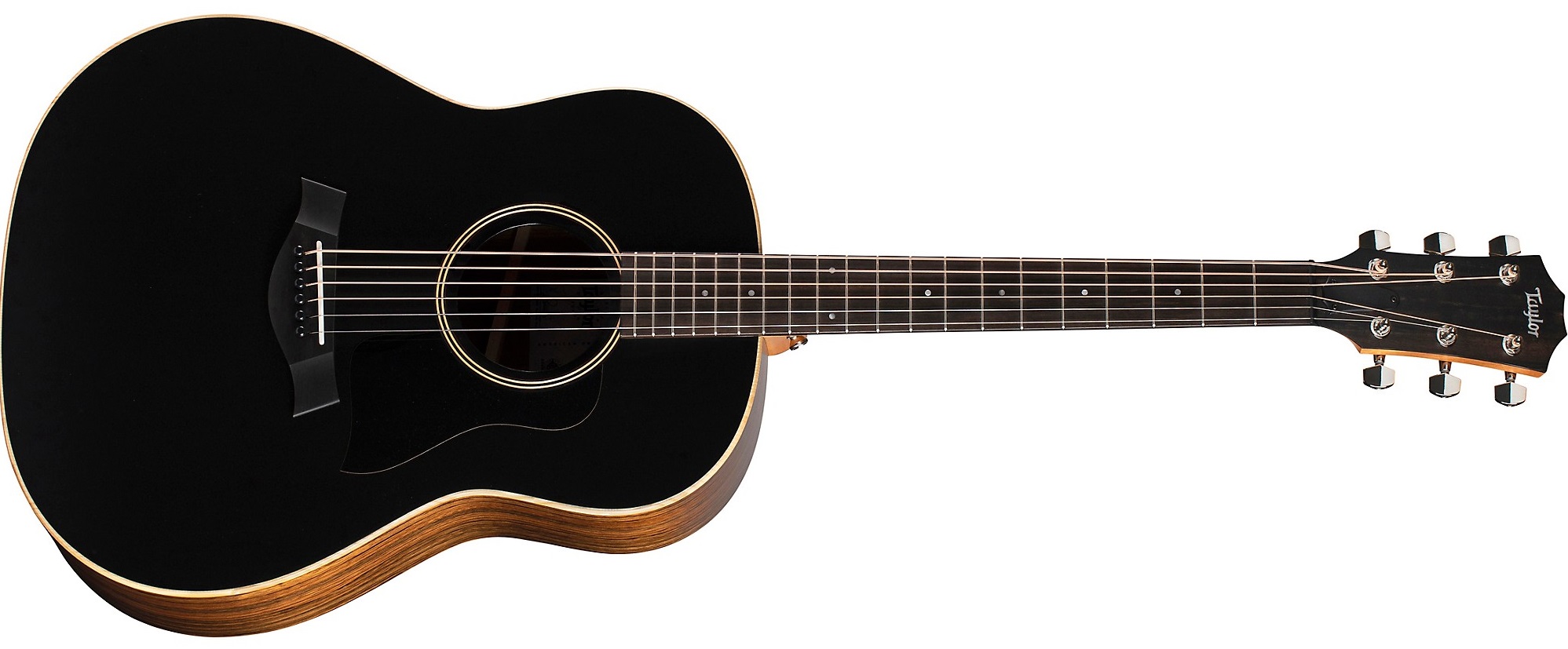
The Taylor American Dream AD17 is a right-handed acoustic guitar that’s radiant in a distinctive Blacktop color.
The whole instrument is carefully crafted using a variety of woods like Ash, Mahogany, Koa, and Spruce for the top material, all of these contribute to the rich tonality of this product.
In the make of the instrument, Ovangkol wood has been utilized for both the body and back of the guitar, enhancing both durability and sound quality.
Moving on to the neck, it’s been composed using strong Mahogany wood which is known for its longevity and stability.
Interestingly, the fingerboard has been fabricated from Eucalyptus which continues the tradition of employing diverse kinds of wood in guitar construction.
Its six strings are made from Nickel, which are not only durable but also provide a crisp sound to complement the guitar’s acoustic nature.
Situated with a 25.5 inches scale length, this guitar provides enhanced playability and a comfortable feel for the guitar player.
With its diverse selection of quality materials and distinct construction, the Taylor American Dream AD17 can truly be called a new milestone in the field of guitar performance and value offered by Taylor.
- My Review
In my experience with the Taylor American Dream AD17 Acoustic Guitar, its striking Blacktop color does indeed capture the essence of the American dream.
As a guitar enthusiast, I found the guitar’s construction – with a Spruce top, Ovangkol back and sides, and Mahogany neck – to be an impressive combination of durability and style.
The Ovangkol, in particular, contributes to the rich, full-bodied sound that emanates from the guitar.
This tonal quality is further enhanced by the Spruce top, commonly recognized in guitar circles for its versatility and ability to resonate a diverse range of tones.
The guitar’s Eucalyptus fingerboard beautifully complements its overall design, simultaneously enhancing playability and aesthetic appeal.
The hand orientation is perfect for right-handed individuals, like myself, providing a comfortable and natural playing experience.
I believe the 6-string configuration to be a standard yet essential feature that often goes underappreciated.
Made from nickel, the strings offered a fresh, bright sound and were easy on the fingers, which I thoroughly enjoyed.
With a scale length of 25.5 inches, it matches the average size of many iconic guitars, making it a comfortable choice for both novices and seasoned players.
However, I did notice that the combination of Ash Wood, Mahogany Wood, Koa Wood, and Spruce Wood for the top material might be a bit overwhelming for traditionalists who favor less complexity in their tone wood choices.
As a guitar enthusiast, I understand that such intricate layering of different woods can result in a unique sound profile, but it could potentially deter those seeking a simpler, more balanced tone.
Despite this, the Blacktop finish of the Taylor American Dream AD17 Acoustic Guitar provides a sleek contrast to the warm, natural tones of the wood construction, adding a modern touch to a traditional instrument.
In my appraisal, this guitar is a beautiful blend of tradition and innovation, and is a testament to Taylor’s commitment to crafting high-quality, aesthetically pleasing instruments.
I must admit that every strum resonated deeply within me, invoking a sense of nostalgia and a longing to explore the musical landscape it so beautifully offers.
This guitar genuinely seems to encapsulate the essence of the American Dream – it is bold, beautiful, and promises a world of untapped potential.
- Pros:
- Diverse Top Material Type.
- Ovangkol Back Sides.
- Right Hand Orientation.
- Cons:
- No significant negatives were found.
My final verdict is that the Taylor American Dream AD17 Acoustic Guitar is a top-of-the-line instrument.
Not only is its blacktop finish aesthetically impressive, but its range of materials including ash, mahogany, koa, and spruce wood contribute to an exceptional sound quality.
The Ovangkol back and sides and mahogany neck display premium craftsmanship that’s hard to beat.
Considering its 25.5 inch scale length and eucalyptus fretboard, it’s a great choice for right-handed players looking for a comfortable and enjoyable playing experience.
So, if you’re after a guitar that offers both value and performance, look no further than the Taylor American Dream AD17.
Epiphone Slash J45 Acoustic-Electric Guitar
Quality Spruce and Mahogany Slash J45 guitar
This is a right-hand oriented acoustic-electric guitar sporting a November Burst color. Made from durable materials, it features a spruce wood top with mahogany neck, body and back, and a laurel wood fretboard. It offers six strings, a piezo pickup configuration, and comes with a protective case.
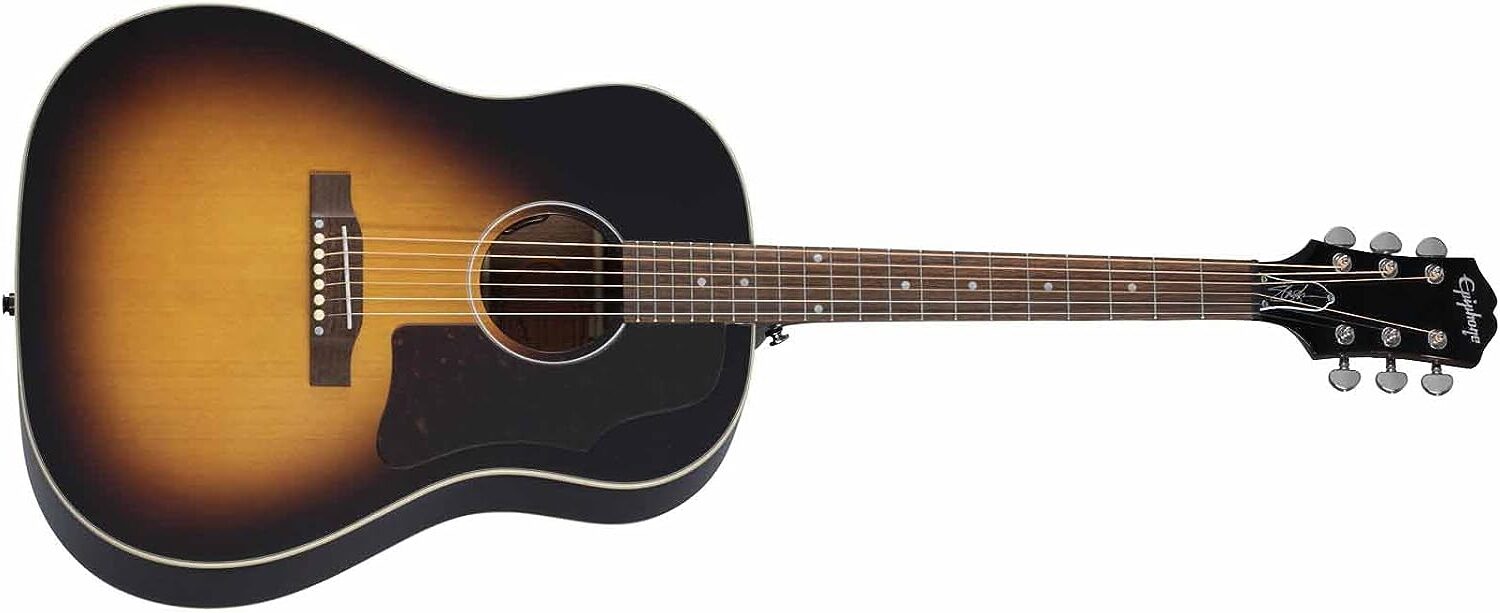
One of the distinguished pieces from Epiphone’s collection is the Slash J45 Acoustic Electric Guitar that comes in a fascinating November Burst hue.
Fashioned from top-quality Spruce Wood, the top of the guitar ensures excellent sound resonance.
Its body and neck both crafted of Mahogany, this guitar doesn’t merely sound good—it feels substantial and reliable.
Adding to the back of the guitar’s charming aesthetic is Mahogany Wood, blending seamlessly with the overall design.
The fretboard, an often overlooked part of a guitar, is made of Laurel Wood, contributing to the instrument’s overall distinctive touch.
This guitar is also equipped with a Piezo pickup configuration, delivering an authentic and natural acoustic sound when amplified.
Suitable for right-handed individuals, it is designed with a right hand orientation.
The instrument is brought together by its six strings, providing a wide array of notes for your musical expression.
Lastly, it comes with a case, providing ease of transport and added protection for your guitar.
So, this Slash J45 Acoustic Electric Guitar is a great piece from Epiphone, well-designed, comfortable, and versatile with an amazing sound quality.
- My Review
Reflecting on my experience with the Epiphone Slash J45 Acoustic Electric Guitar, I was truly amazed by the fine craftsmanship of this instrument.
The most striking aspect was the beautiful November Burst color, which gave it an aesthetic appeal that flaunted this instrument’s quality and sophistication.
The selection of spruce wood for the top material was indeed an excellent choice, as it produced a bright and robust tone that I thoroughly appreciated.
The body and neck composed of mahogany significantly contributed to a warm and full sound, a tonal quality that is highly sought after by many guitar enthusiasts like me.
Moreover, the laurel wood fretboard further aided in producing clear and bright tones, greatly enhancing the overall playing experience.
The guitar is equipped with Piezo pickup configuration, which allowed me to amplify my music without losing its natural acoustic resonance.
“A perfect blend of electronic and acoustic features,” I should say.
The right-hand orientation suited me perfectly, but it might be a bit challenging for the left-handed guitarists out there.
Featuring six strings, this guitar offered a broad spectrum of notes and chords to play, thus broadening my musical creativity.
Despite all its excellent attributes, I noticed that the Epiphone Slash J45 Acoustic Electric Guitar is quite hefty, which may not sit well with folks who prefer lighter guitars.
And while its price tag is undoubtedly justified by its top-notch features and quality, it might be considered steep for amateurs or those on a tight budget.
From my perspective, this guitar is more suitable for experienced players, because of its complex features and higher cost.
Nonetheless, I found the Epiphone Slash J45 Acoustic Electric Guitar to be an absolutely delightful instrument to play.
The fine construct, superior sound quality, and stunning design all add up to create a guitar that I am thrilled to have had the opportunity to try.
To anyone considering this guitar, take it from my experience, it is certainly worth every penny.
- Pros:
- Great value for the price.
- High-quality materials and construction.
- Impressive sound output.
- Cons:
- Not suitable for left-handers.
My final verdict is that the Epiphone Slash J45 Acoustic Electric Guitar is a splendid choice for anyone whether they’re a novice or an experienced player.
This guitar, with its impressive November Burst color and high-quality Mahogany body, offers not only exceptional aesthetics but superior sound quality as well.
It stands out in terms of comfort and durability, thanks to its Mahogany neck and Spruce Wood top material.
Furthermore, its Piezo pickup configuration ensures excellent tonal versatility, making it suitable for a wide range of music styles.
I can confidently recommend this guitar as is it provides value worth each penny spent.
Martin 000-15M Acoustic Guitar
Premium handmade mahogany guitar, perfect for gigging.
This Mahogany-constructed guitar offers a lively, complex tone and superior sound perfect for gigs. The hand-crafted design coupled with features such as a simple dovetail neck joint and non-scalloped X-brace makes it suitable for late-night jams and studio sessions. Its high playability coupled with the inclusion of a hard-shell matte case, makes it a commendable choice for the working musician.
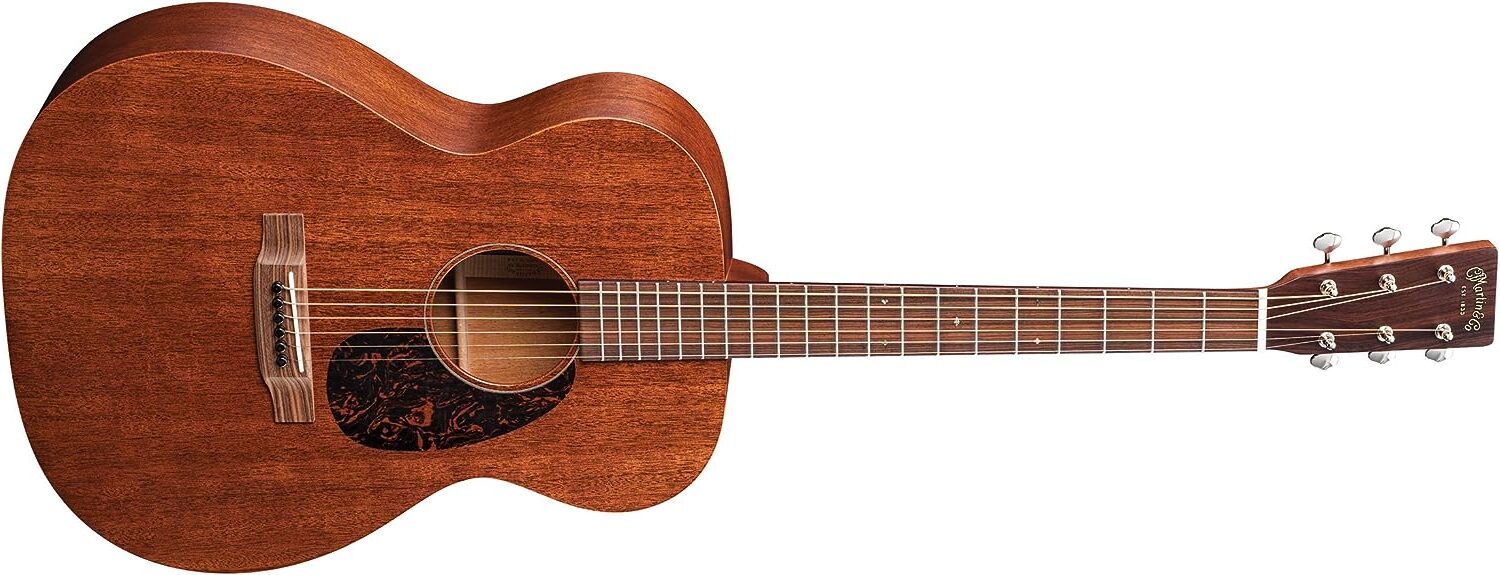
The Martin Guitar 000-15M is a professional-quality acoustic guitar, uniquely designed for the dedicated musician in mind. It’s crafted with a robust Mahogany body, delivering a vibrant, immersive sound with intricate tonal richness.
The model flaunts an elegant, auditorium-style body shape which not only enhances the instrument’s sound output but also facilitates convenient strumming.
A notable highlight is its satin finish and open nickel string tuners, giving it a captivating appearance.
Crafted intentionally for working musicians, this guitar comes with a worked-in dovetail neck joint, a standard taper neck, and a non-scalloped X-brace. The accompanying sturdy matte case allows for effortless portability.
All of Martin’s guitars in the 15 series are handmade from top-quality Mahogany, promising durability and the capacity to withstand long, intense music sessions.
In terms of playability, the Martin Guitar 000-15M is designed to enhance your playing experience, irrespective of your skill level or preferred music genre.
Finally, it’s worth mentioning the Martin 15 Series itself, known globally for their unmatched quality, craftsmanship, and tone.
Technical specifics include dark Mahogany colour, Rosewood fretboard and right-hand orientation with six nickel strings.
The product line provides a variety of body styles and sizes, catering to diverse playing styles and musical genres.
Each model within the Martin 15 series contributes unique features, enhancing the individuality, performance and playability of your guitar collection.
For nearly two hundred years, musicians globally have trusted this brand for top-tier guitars and string products.
This particular model, like all Martin guitars, are authentically handmade, continuing to set industry standards.
- My Review
Once you lay your hands on this magnificent piece, the Martin Guitar 000-15M, its enthralling mahogany construction immediately stands out.
The rich satin finish gives it an appearance that’s as mesmerizing as its melodious tones, ensuring that it steadily holds its ground in the limelight.
As a professional, I found the guitar equipped for the gig life, complete with features that make it a preferred choice, especially its standard taper neck and auditorium body that aid in delivering an excellent playability and superior sound.
With this guitar, I was able to achieve an iconic tone synonymous with Martin’s brand, making it a delight for musicians in genres ranging from rock, jazz, to country, folk, and bluegrass.
The acoustic sound this guitar radiates is vibrant and enriched by its solid-wood construction.
It’s noteworthy that each string note pays tribute to the skilled hand-craft make.
The robustness of the Martin’s 15 Series guitars is ineffable, designed as they are for the long haul, withstanding extended studio sessions, late-night jamming, and rigorous strumming or picking.
From a guitarist’s standpoint, the practical benefits of this guitar have been significantly enhanced by impressive playability.
Particularly pleasing for me was that the dreadnought body shape produced the most resonant tones, while the auditorium type led to a delightful projection of balanced melodies.
This guitar’s finish and detailing, particularly the matte scheme and color, thumbs a lift to its aesthetic superiority.
While it is undoubtedly arresting to the senses in terms of visuals, its distinct acoustic tone also sets it apart as a truly unique model.
Regardless of the music genre you prefer, this guitar offers a perfectly balanced blend of performance, playability, and personality.
A small caveat that I found was the unevenness of the frets at certain parts, which disrupt the smooth transition of fingers along the fretboard.
However, overlooking this minor hitch, for its excellent tonal range and enhanced playability, the Martin 000-15M delivers a sturdy, high-class performance that stays true to the unrivaled craftsmanship that Martin’s products are renowned for worldwide.
- Pros:
- Exceptional sound quality.
- Durable mahogany construction.
- Enhanced playability.
- Cons:
- Inconsistency in fret height.
- No built-in pickups.
- Does not include hard case.
My final verdict is that the Martin Guitar 000-15M is an excellent investment for any working musician.
This guitar not only boasts a professional sound and appearance, but it’s designed to withstand the rigors of gig life with its sturdy mahogany construction.
With its easy playability and versatile sound, it’s well-suited to a diverse range of music styles from rock, country, to jazz.
Considering the craftsmanship and tone, Martin Guitars are known for, this model is a true value for money.
Taylor Guitars 224ce-K DLX Koa Deluxe Acoustic-Electric Guitar
Mid-priced guitar with resonant tone and stunning koa design.
This acoustic-electric guitar, from the renowned Taylor brand, beautifully blends high-quality materials with exceptional craftsmanship. Made with a koa laminate body and a solid Hawaiian koa top, it boasts a full, resonant tone. It also features a faux pearl rosette in a fishbone pattern, black binding, small diamond inlays, and chrome tuners.
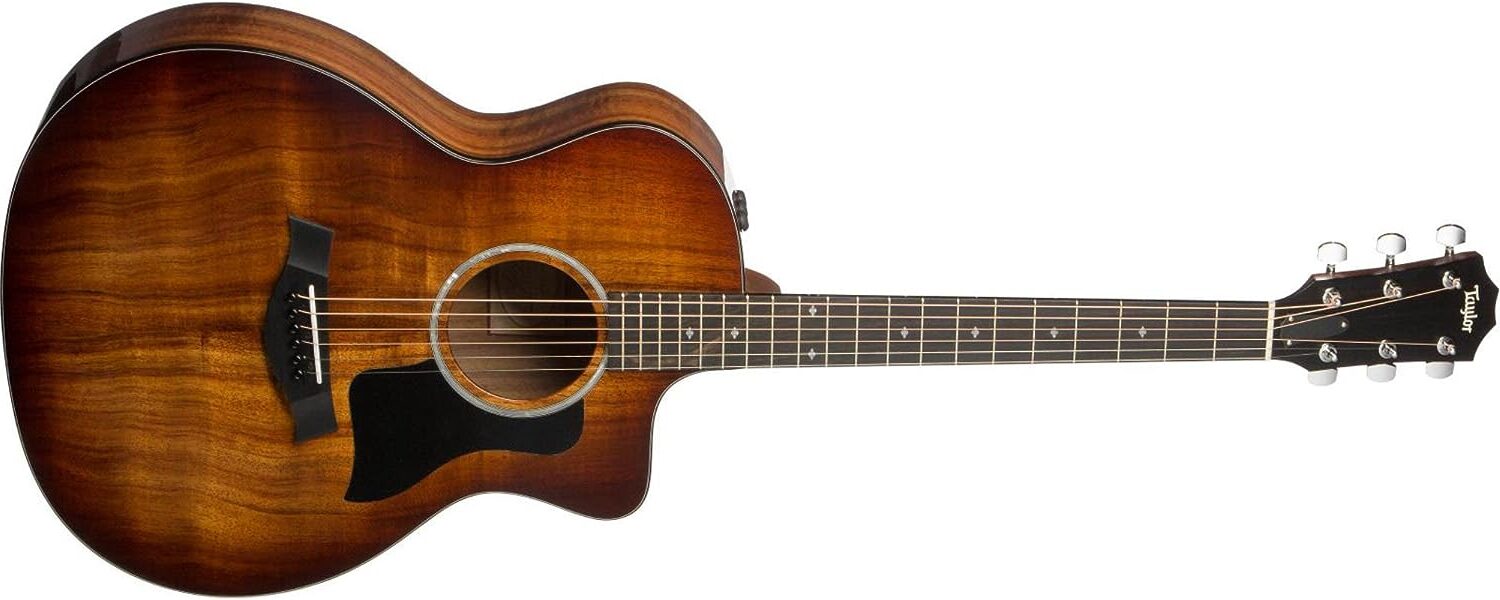
From the renowned house of Taylor Guitars, we have their stylish 224ce-K DLX Koa Deluxe Grand Auditorium model.
This is an acoustic-electric hybrid guitar, offering the best of both worlds.
What immediately grabs your attention is its stunning Hawaiian Koa wood top that is not just pretty to look at but also greatly contributes to its balanced, focused sound.
Ensuring a robust build, both the body and back of the guitar are made of Koa Laminate.
Apart from that, it’s noteworthy that the guitar’s neck is crafted from Mahogany and the fretboard is of Ebony Wood, adding to its durability and playability.
Equipped with Phosphor Bronze strings, this guitar is gentle on your fingers while ensuring a great sound.
Keep in mind, this guitar is designed with a right-hand orientation.
It also features a fixed bridge system and a scale length of 25.5 inches, offering a comfortable playing experience.
The guitar’s unique design is further amplified with chrome tuners and an Italian acrylic small diamond inlays.
It’s worth mentioning that the synthesized sound produced by the Grand Auditorium body of this guitar is not just loud, but extraordinarily rich in character.
Lastly, a beautiful single-ring faux pearl rosette in an interlocking fishbone pattern provides a remarkable touch to this amazing musical instrument.
- My Review
Upon getting my hands on the Taylor Guitars 224ce-K DLX, the first thing I noticed was the premium quality of the materials used.
The top, body, and back are made of an admirable koa laminate, a species of wood hailed from Hawaii that has unique tonal qualities not found in other types of wood.
The added touch of the ebony wood fretboard and the mahogany neck just increases its overall appeal.
On top of this, it is worth mentioning that this guitar is designed for right-handed players and comes with a fixed bridge system.
This perfect combination of materials not only makes the guitar look aesthetically pleasing, but also contributes to a powerful and stylish tone that truly stands out.
What truly amazed me was the guitar’s size and weight, it is perfectly balanced with an impressive 25.5 inch scale length.
Looking just at the build and materials used, this guitar is a fine piece of craftsmanship.
Moving on to the sound, I was not disappointed.
Without any amplification, the guitar has a massive sound, thanks to the body material and the grand auditorium shape.
Even when amplified, the guitar maintained its impressive, rich, and resonant sound.
It’s an amazing instrument that can handle anything from a mellifluous fingerpicking style to a more aggressive strumming style without losing its balanced tone.
This versatility makes it a suitable choice for both beginners and professionals alike.
On the downside, the factory set up was not up to my expectations.
It required some tweaking and adjustments to the truss rod and bridge saddle to make it play the way I wanted.
It’s worth noting that the pick-up system and eq didn’t impress me much.
It felt inflated between sets of two strings, causing a noticeable imbalance between the lower and higher register strings.
However, once the guitar was tweaked to my satisfaction and, despite the cons, the Taylor Guitars 224ce-K DLX’s benefits undoubtedly capitalize over its minor shortcomings.
This guitar is beautiful, and, in my opinion, the selective mix of koa laminate and a grand auditorium body gives it a unique blend of warmth matched with an immediate response.
I found the Taylor Guitars 224ce-K DLX Koa Deluxe Grand Auditorium Acoustic-Electric Guitar to be a fantastic instrument with very few flaws that are heavily outweighed by its positives.
It’s well worth exploring, especially if you appreciate a guitar with a fantastic build quality, excellent tone, and an awe-inspiring finish.
- Pros:
- Beautiful and well-crafted design.
- Profound and balanced sound.
- Included sturdy, high-quality case.
- Cons:
- Some units may have setup issues.
- Inconsistent pickup and EQ system.
- Potential for manufacturing faults.
My final verdict is that the Taylor Guitars 224ce-K DLX Koa Deluxe Grand Auditorium Acoustic-Electric Guitar is an exceptional musical instrument that offers unparalleled sound and quality.
With its resonant tone and distinctive design features, it truly stands out in the market of mid-priced guitars.
The Hawaiian Koa wood craftsmanship not only makes it visually appealing but also contributes to its stellar performance.
Whether you are a professional musician requiring an instrument for performances, or an amateur hobbyist, this Taylor Guitar will absolutely satisfy your musical needs.
In all, it is a worthy investment that offers excellent value in terms of both aesthetics and acoustic quality.
Yamaha Red Label FGX5 Acoustic-Electric Guitar
Solid wood, quality electronics, Yamahas trusted craftsmanship.
This acoustic-electric guitar boasts a solid Sitka spruce top with Atmosfeel electronics, and solid mahogany back and sides. The neck is made out of African mahogany, ensuring a sturdy, reliable structure. Included are 6 strings, piezo pickup configuration, and the guitar is designed for the right-handed orientation.

Take a seat and let’s chat about Yamaha’s Red Label FGX5. It’s a gorgeous acoustic-electric guitar, standing out in a natural color.
Made by the reputed Yamaha brand, this guitar has a composition that screams quality. Its top is made from an intriguing blend of woods, including ebony, spruce, and mahogany.
Beyond the top, the rest of the body follow suit, being crafted from nothing less than solid mahogany wood.
The neck is also a point of interest, made from African mahogany, it’s sure to give you a fabulous playing experience.
Additionally, it has a special standout feature of a Piezo pickup configuration, paired with Atmosfeel electronics.
These combine for a perfect sound, regardless of the situation or location.
The fretboard too, is a story in itself, it is made of durable and slick ebony wood.
This beautiful instrument is designed for right-handed players and houses six strings.
Yamaha’s Red Label FGX5 isn’t just an instrument, it’s a piece of art boasting impressive craftsmanship and unparalleled sound quality, making it an exceptional choice for musicians of all levels.
- My Review
I’ve had the pleasure of getting familiar with the Yamaha Red Label FGX5, an instrument that captures attention with its natural color finish.
One striking feature was the solid Sitka spruce top, which delivered a sound that wrapped around me like a warm blanket on a cold night.
This was complemented by solid mahogany back and sides, generating a resonance and depth that some may say only comes from a finely crafted guitar.
True to its acoustic-electric nature, this guitar comes equipped with Yamaha’s Atmosfeel electronics, offering optimal flexibility and control for when I took to the stage.
Nestling in the crook of my hand was the African mahogany neck that felt both robust and smooth, a testament to the craftsmanship of Yamaha’s design team.
Interestingly, the top material of the guitar is a fusion of woods, namely mahogany, ebony and spruce, adding to the complexity and richness of the sound.
The body and back, made of solid mahogany, along with the neck, which is also mahogany, leads to a smooth, rounded yet substantial sound.
The ebony fretboard was comfortable under my fingers, enhancing playability for even the most complex arrangements.
Adding to the overall charm of the instrument, the guitar has a piezo guitar pickup configuration.
To my delight, the FGX5 caters to right-handed players, providing a guitar with traditional orientation and feel.
What caught me was the loud, clear sound that bounced from its six-strings, a distinctive trait of a well-rounded guitar.
Renowned for its quality, Yamaha did not disappoint with this Red Label Folk guitar.
Without a doubt, the FGX5 delivers an experience enriched with a rich full tone and an exceptional resonance.
Whether I was running my fingers across the fretboard for a simple melody or experimenting with a more complex arrangement, the FGX5 responded with the grace of an instrument in a far higher price category.
In my opinion, the FGX5 is not just a guitar, but a musical partner one can rely on for the journey ahead.
- Pros:
- High quality sound and resonance
- Rich bass and easy-to-play fretboard
- Good value for the price
- Cons:
- Availability issues in stores
- Heavy case
My final verdict is that the Yamaha Red Label FGX5 is a top-quality acoustic-electric guitar in terms of sound and build.
The combination of Mahogany Wood, Ebony Wood, and Spruce Wood materials make this guitar not only visually appealing but also significantly affects the sound quality.
Moreover, the Atmosfeel Electronics provide authentic and naturally dynamic sound, allowing for a truly immersive playing experience.
Lastly, its Right Hand Orientation and 6-string configuration make it a versatile instrument suitable for a wide range of musical genres.
Takamine EF341SC Legacy Series Acoustic-Electric Guitar
Versatile sound with precision quality craftsmanship.
The Takamine EF341SC Legacy Series Acoustic-Electric Guitar has a cutaway body, solid cedar top and mixture of maple and mahogany building materials. This guitar is equipped with CT4B II electronics that deliver a rich, acoustic sound at any volume levels. Versatile and visually appealing, it features an adjustable bridge system, built-in tuner, and a glossy black finish akin to stage lights.
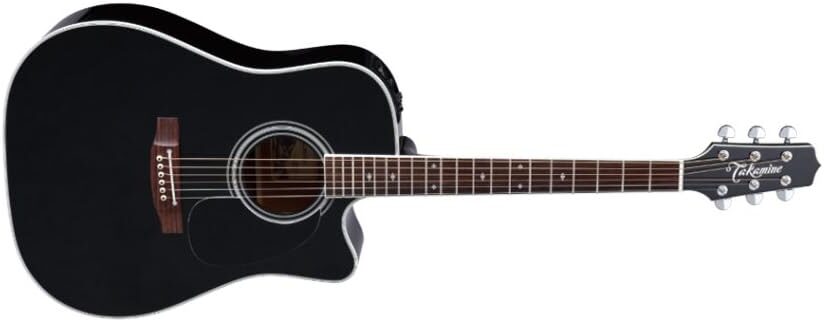
This particular Takamine EF341SC Legacy Series guitar comes in a sleek, black gloss finish that sure to catch the eye.
In terms of the sound it produces, it’s fitted with CT-4B II electronics, capable of providing a natural acoustic resonance, no matter the volume level.
Your fingers won’t miss a single note with the added benefit of a cutaway body style.
Made with a solid cedar top, this guitar can handle everything from soft, tranquil melodies to powerful, rocking chords.
Complemented by a laminated maple back and sides, this body design acts as a perfect mirror, reflecting the incredible tone generated by the soundboard.
Artistically constructed in a pro series facility dedicated to crafting precision quality instruments, this guitar has garnered favour amongst professionals from different music genres.
The mahogany neck is attached securely to the body using a reliable, traditional dovetail joint.
Amplified sound is taken to new heights with the combination of Takamine’s CT4B II preamp system and a unique Palathetic under-saddle pickup.
This guitar also comes with a highly revered CT4B II preamp system boasting a three-band EQ, volume control, and an inbuilt tuner.
- My Review
From the moment I laid my hands on the Takamine EF341SC Legacy Series Acoustic-Electric Guitar, I was captivated by its impeccable gloss black finish.
Its distinctive aesthetic, coupled with a sturdy build, ensures it stands out on any stage and grabs attention without trying too hard.
Delving into the materials involved, the solid cedar top on this guitar contributes significantly to its robustness, facilitating sweet mellow passages along with powerful chords with the same level of proficiency.
Importantly, I observed that the laminated maple back and sides effects an ideal reflection of the tone generated by the soundboard.
The assurance of durability doesn’t stop at the body; the mahogany neck is bonded to the body with an ultra-strong dovetail joint, reinforcing the structural integrity of the instrument.
As an avid guitar enthusiast, I found the inclusion of Takamine’s CT4B II preamp system paired with the unique Palathetic under-saddle pickup quite noteworthy.
This combination results in a peerless amplified response, enabling the delivery of a naturally resonant acoustic sound at all volume levels—a feature that is paramount for live performances and studio recordings alike.
Another facet that warranted my appreciation was the adjustable guitar bridge system.
It allows easy fine-tuning of the guitar’s action to suit individual playing styles, thereby providing an optimized playing comfort.
While the instrument indeed shines with multiple strengths, I did notice that the tonal richness faltered a bit when playing with a capo at higher frets.
This slight twanginess could make a substantial difference if you demand exquisite tone quality over an entire playing range.
In contrast, if you primarily play without a capo or at lower frets, the guitar’s sound quality is exceptional.
Finally, one must consider that despite a few sound quality concerns, the Takamine EF341SC stands as a viable option for those seeking a visually captivating, versatile, and durable Acoustic-Electric guitar.
With mature utilization and care, it promises to age well and can certainly serve as a reliable companion for your musical expressions.
- Pros:
- Durable and reliable for gigs.
- Improves sound over time.
- High-quality CT4B II preamp system.
- Cons:
- Possible quality control issues.
- Not as appealing open sound.
- May not inspire creative writing.
My final verdict is that the Takamine EF341SC Legacy Series Acoustic-Electric Guitar Black is an instrument of impeccable quality.
The solid cedar top, laminated maple back and sides, along with its gloss black finish not only make it a true beauty to behold but also contribute to producing a soulful, resonant sound regardless of the genre.
Its handcrafted design and versatility make it a reliable partner for professional musicians and the CT4B II preamp system ensures an unrivalled amplified response.
The fact that it is comfortable to play and comes with a built-in tuner is the icing on the cake, making it a worthwhile investment for any guitar enthusiast.
Fender CD-60SCE Solid Top Dreadnought Acoustic-Electric Guitar
Quality Fender guitar with valuable accessories bundle.
This guitar offers easy upper-fret access with its Venetian-cutaway body and an easy-to-play neck with rolled fingerboard edges. It offers excellent quality sound with its solid spruce top, mahogany back and sides, and Fishman Classic Design pickup/preamp. The handy bundle includes a hard case, cable, tuner, strap, extra strings, picks, an instructional DVD, and a polishing cloth to ensure a complete and practical experience.
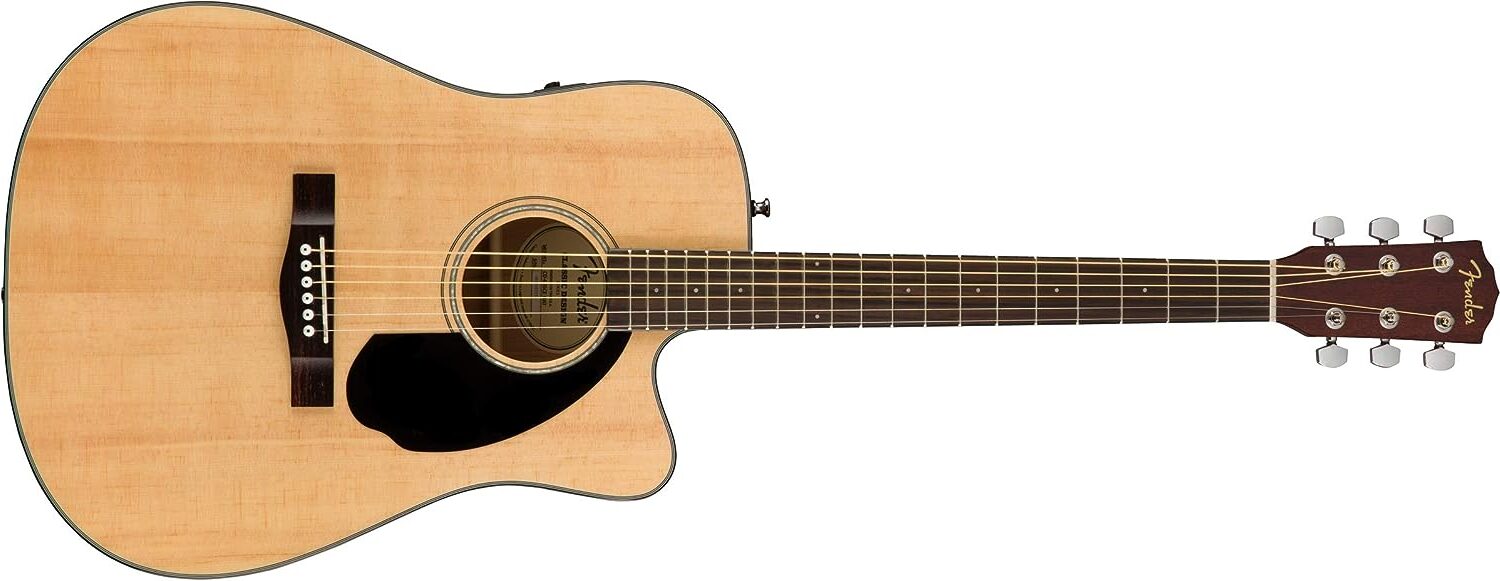
The Fender CD-60SCE Dreadnought Acoustic-Electric Guitar is not only visually appealing with its natural finish but comes as a complete package including a hard case, tuner, strap, strings, picks, a guide DVD, and a cloth for polish use.
Constructed with a Venetian-cutaway body, it helps the guitarist access the higher frets with ease.
A noteworthy feature of this guitar is its solid spruce top with scalloped ‘X’ bracing which lends a superiority to its resonance.
Adding to the guitar’s beauty and tonal quality, the back and sides are made from premium mahogany wood.
The neck, which is also made from mahogany, is convenient to play, owing to its rolled fingerboard edges.
The Fishman Classic Design pickup/preamp attached to the guitar, enhances the acoustic sound once it’s plugged in.
Looking at the details, the top material is spruce and the body is a combination of laminated and solid wood – a remarkable blend for durability and sound clarity.
The back of the guitar is made from mahogany, again, while the fretboard is constructed using rosewood, a favored choice for many guitarists due to its warm tones.
The design of the right-oriented guitar even includes a fixed bridge system with a pickup configuration of ‘S’.
- My Review
Upon first glance, I’m struck by the sheer aesthetic beauty of the Fender CD-60SCE Solid Top Dreadnought Acoustic-Electric Guitar, particularly its natural spruce top and mahogany back and sides.
Not only does the design hold a classic elegance, but the practical functionality is also evident in its Venetian-cutaway body style, allowing for easy upper-fret access.
This feature alone can significantly enhance the guitar playing experience, particularly for those who relish in high pitch solos.
Upon picking up the instrument, I instantly feel the comfortable fit of the neck, which is complemented by the rolled fingerboard edges.
This added comfort facilitates an easy-moving, smooth playing experience that is perfect for beginners yet sophisticated enough for experienced players.
Then, of course, there’s the Fishman Classic Design pickup preamp, which provides an excellent electronic interface for those wanting to crank up the volume or tweak the tone of this guitar.
I’ve further noticed some minor factory imperfections that could slightly diminish the overall aesthetic value, specifically regarding slight adhesive blemishes around the neck and body.
However, these issues seem to be quite minimal and should not overly affect the performance or overall attractiveness of the instrument.
Moving on to the accessories, they are of equally impressive quality including a hard case, tuner, cable, strap, strings, and even an instructional DVD for beginners.
My attention was really grabbed by the exceptional quality of the hard case, a component that is particularly important for those who need to travel with their instrument.
From a playability perspective, I did notice the action to be a bit higher than expected, which could be a minor setback for those looking for lower action.
The good news is that, for those with the required know-how, it can be adjusted to fit personal preferences.
Despite these minor hiccups, I found the overall tunability of the guitar to remain firmly intact, producing a sound quality not often found in this price range.
By taking the time to properly set it up, remarkable playability can be achieved.
Disappointingly, I’d be amiss to not mention the apparent durability issues that I have uncovered.
The seemingly weak wood structure, as exhibited by a fret buzz, does pose long-term reliability concerns.
Such components, unfortunately, may deter some potential buyers.
But in all fairness, despite its few flaws, the craftsmanship, aesthetic appeal, and sound quality of the Fender CD-60SCE Solid Top Dreadnought Acoustic-Electric Guitar surpasses many within this price range.
- Pros:
- Guitar has superb built quality.
- Offers great value with bundle package.
- Easy to play with low neck action.
- Cons:
- Possible issues with fret buzz on 13th fret.
- Potential structural weakness, prone to cracking.
- Problems with residue from protective film.
My final verdict is that the Fender CD-60SCE Solid Top Dreadnought Acoustic-Electric Guitar is an outstanding instrument that is versatile and expertly crafted.
Its solid spruce top with scalloped “X”-bracing provides a rich, resonant sound unheard of at this price point, making it suitable both for beginners and experienced players alike.
The easy-to-play neck and Venetian cutaway provide comfortable playability and easy access to upper frets.
The inclusion of a Fishman Classic Design pickup/preamp and extra accessories in the bundle adds an exceptional value for the price.
I would highly recommend this acoustic-electric guitar bundle for anyone in the market for a high-quality, affordable guitar.
Takamine EF340S TT Acoustic-Electric Guitar
Vintage sound and feel with modern technology.
The guitar flaunts a solid spruce ‘Thermal Top’, driven by solid American mahogany back and sides. Enhanced with faux tortoise shell binding, pickguard, and open gear butterbean tuners, it presents a perfect blend of vintage sound and contemporary technology. It also features Takamine’s renowned ‘Palathetic’ pickup and a high-performance TLD-2 line driver preamp for superior sound quality.
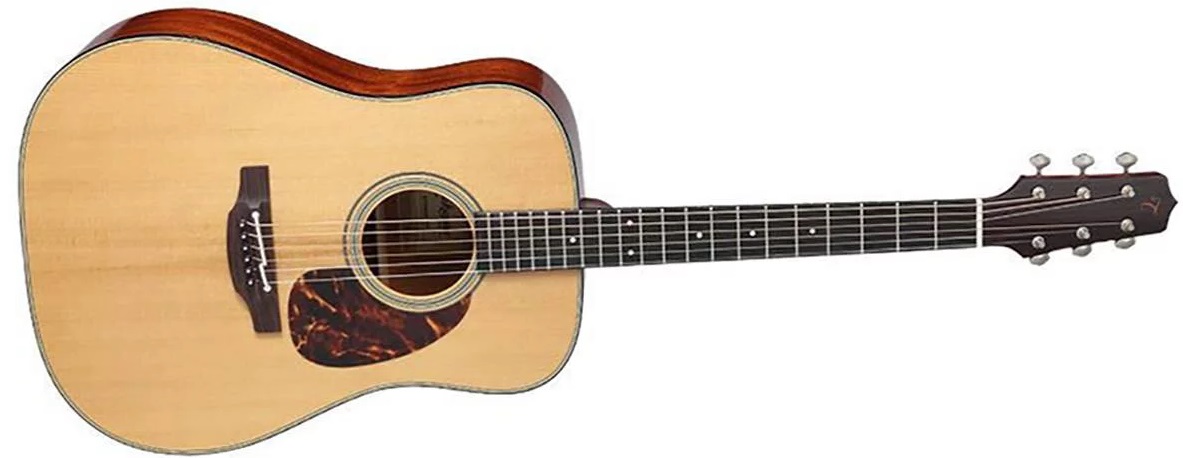
Takamine EF340S TT is an acoustic-electric guitar that features a thermal top design. It comes with a sleek, high-quality hard case for transport and safeguarding.
Renowned for its solid thermal Spruce top construction, which amplifies the instrument’s sound and resonance. This adds enormity to the sound that the guitar produces.
The body, composed of solid Mahogany with the back and sides also crafted from the same material, gives this guitar a rich, full sound.
The neck is also made from Mahogany wood, ensuring durability and a stable grip for the guitarist. In addition, the fingerboard is made up of Ebony, adding a layer of beauty and comfort for the player.
This guitar specificity is characterized by a gloss natural finish, giving it a classic and elegant appearance.
The Takamine EF340S TT includes a TLD-2 Line Driver Preamp, offering diverse tonal options and control.
This model comes in a natural color, and unique features like the Piezoelectric pickup configuration, designed for right-hand orientation and a fixed bridge system.
The Takamine EF340S TT is a traditional non-cutaway dreadnought guitar. Its powerful, balanced sound and quick response are often compared to the qualities of a well-aged vintage guitar, right out of the case.
The aesthetics of the guitar are enhanced by faux tortoise shell binding and pick guard, open gear butterbean tuners, and an understated ‘T’ logo. This combination enhances the vintage sound and look of this remarkable instrument.
- My Review
I found the Takamine EF340S TT Thermal Top Acoustic-Electric Guitar to be an extraordinary instrument that effortlessly combines traditional design features with modern technology.
The solid thermal spruce top is one of the highlights, lending a mature tone which is usually observed only in well-aged guitars.
Also, the American mahogany used for the back and sides further enhances the sound, producing a rich and balanced output that beckons enthusiasts and professionals alike.
It is evident that the faux tortoise shell binding and open gear butterbean tuners don’t just add to the aesthetics, they bring out the vintage appeal, adding an extra dimension to the vintage sound emitted by this beauty.
What pleasantly surprised me was, how well the Takamine ‘Palathetic’ pickup and the new low profile TLD-2 line driver preamp worked in sync, providing an immaculate sound, characterized by an organic transparency that is rare to find.
While I was impressed by the stellar acoustics, I was equally fascinated with the gloss natural finish of this guitar.
The use of high-quality ebony wood for the fretboard enhances the playing experience, making it smooth and offering consistency in tone and response.
While I am mostly a right-handed player, I do appreciate the attention paid towards the hand orientation offering the player much-needed comfort and flexibility during performances.
The sturdy solid mahogany neck ensures comfortable playing for extended periods, a feature I personally can’t ignore as a lover of long jamming sessions.
Despite the absence of a cutaway, I found the accessibility to the upper registers quite satisfactory.
One aspect I must mention, that provides this guitar it’s near perfect balance is the fixed bridge system.
It stands up to the demand of any playing style ensuring a stable and precise tuning throughout.
As the cherry on top, the inclusion of a hard case provides an added protection, assuring that the treasure within remains intact.
All things considered, this Takamine guitar is a blend of both, extraordinary craftsmanship and sound aesthetics, making it a worthy addition to any guitar collection.
If you are seeking an acoustic guitar that offers a classic look, supreme sound, and unmatched playability, the Takamine EF340S TT Thermal Top Acoustic-Electric guitar should certainly be under your consideration.
- Pros:
- High quality materials used.
- Included hard case for protection.
- Excellent balance, response, and projection.
- Cons:
- No significant negatives were found
My final verdict is that the Takamine EF340S TT Thermal Top Acoustic-Electric Guitar is a truly exceptional instrument.
The high-quality materials, including the solid thermal spruce top and mahogany sides and back, result in remarkable sound quality that rivals that of a well-played vintage guitar.
Additionally, the TLD-2 Line Driver Preamp and Takamine ‘Palathetic’ pickup provide impressive transparency and organic sound amplification.
From aesthetic appeal to its performance, it’s clear that great care and craftsmanship have been invested into this guitar.
Considering all these features, this guitar offers excellent value for its price and is well worth considering for serious players.
Taylor 214ce Deluxe Cutaway Acoustic-Electric Guitar
Versatile, durable guitar with exceptional sound clarity.
This is an exceptional acoustic-electric guitar with a Grand Auditorium shape and a 6-string design. It boasts features such as a layered rosewood body, Sitka spruce top, and a sapele neck. With exquisite playability, full articulation, and Taylor’s professional-grade pickup, it delivers impeccable intonation and signature tonal clarity.
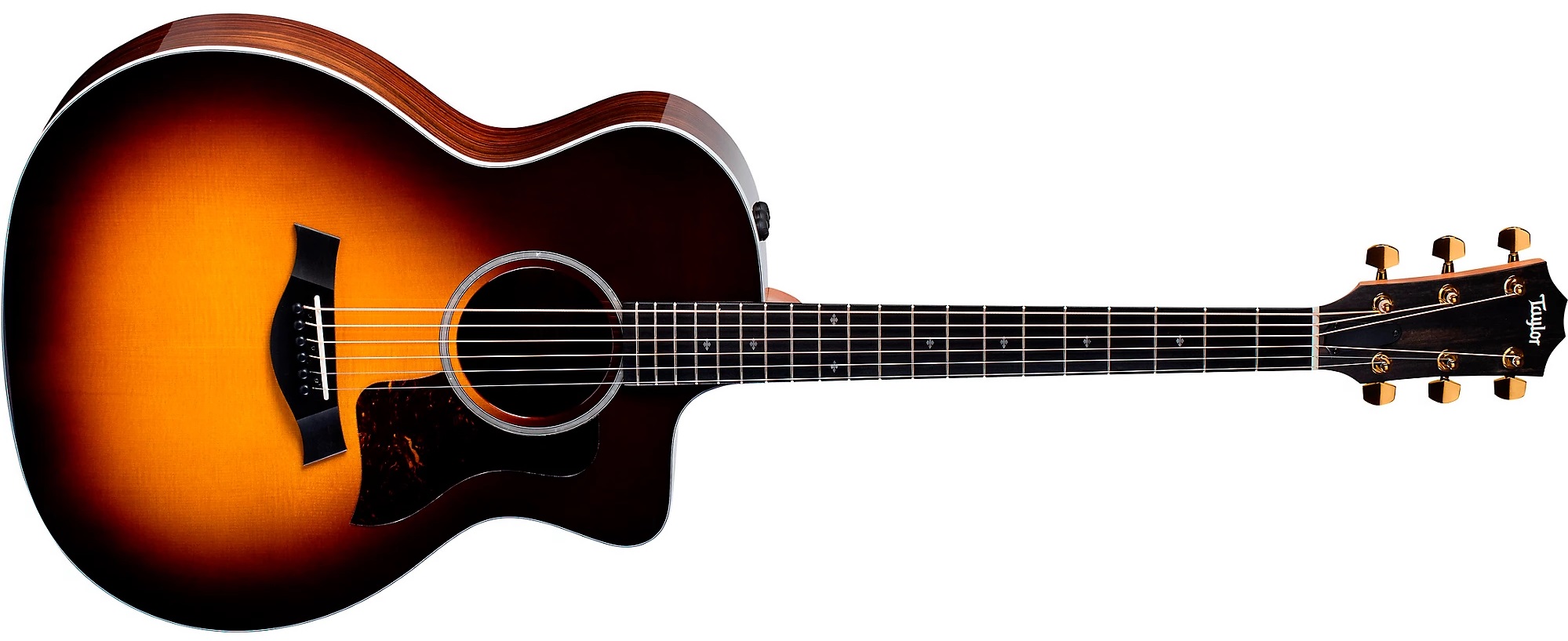
You’re looking at the Taylor 214ce Deluxe Grand Auditorium Acoustic-Electric Guitar that sports a refined, natural finish.
This guitar is characterized by its Grand Auditorium shape with six strings, perfect for a variety of musical styles.
The back and side area is crafted from layered rosewood and it features a generously-sized scale length of 25-1/2″.
Notably, its top is made from Sitka spruce, a popular choice of wood for superior sound projection.
Designed with Expression System electronics, this guitar ensures smooth and seamless amplification.
The guitar also includes a cutaway, enabling easy access to the higher frets.
The nut and saddle are made from NuBone and Tusq respectively, increasing tuning stability and enhancing tone.
The neck sports a sapele wood heel and the forward shifted pattern bracing offers added structural integrity.
With an ebony fretboard, small diamond inlays, and an attractive Indian Rosewood headstock overlay, this guitar is not only built for performance but also for aesthetics.
It’s primarily designed for right-handed players and comes with alloy steel strings for rich, resonant sound.
The guitar belongs to Taylor’s 200 Deluxe Series, promising both aesthetic appeal and uncompromised performance.
It’s designed with an all-glossy body that balances durability with stunning design.
Furthermore, the Grand Auditorium body shape is known for its versatility, offering balanced sound whether you’re fingerpicking or strumming.
Lastly, this guitar ships with a hard case made specifically by Taylor to ensure maximum protection for your instrument.
- My Review
There’s a certain magic to the Taylor 214ce Deluxe Grand Auditorium Cutaway Acoustic-Electric Guitar that just begs to be played.
Upon the first strum, I immediately noticed the guitar’s crisp and full sound, courtesy of the Sitka spruce top wood and layered rosewood back and sides.
These combined tonewoods ensure that the guitar resonates with a beautiful clarity and volume, which is particularly excellent for lighter fingerpicking as well as medium strumming.
NuBone nut/Tusq saddle contributes to the overall intonation of the guitar, making it virtually impeccable.
The Venetian cutaway body gives it a sophisticated aesthetic touch, besides offering easy access to higher frets.
When I turned to the guitar’s electronic components, the story, unfortunately, was a bit different.
The guitar, when plugged into an amp, seemed to lose its initial clear, balanced sound, and instead offered slightly distorted tones and an over-amplification of non-musical sounds like pick-guard strikes and squeaks.
Dialing back to the comfort of this instrument, I marveled at how the neck, made from Sapele wood, naturally suited my grip and made it easy for my fingers to glide across the ebony fretboard.
The lack of a gloss finish on the neck meant there was no annoying stickiness to interrupt my playing.
In terms of duration, this guitar can stay tuned for a long time, even with daily use, which says a lot about the quality of the tuning pegs and alloy steel strings.
One shortfall I noticed was that the guitar required some work when plugging it in to find the balance between feedback and a sound that doesn’t come off as too thin.
Despite some reservations about the electronic aspect of this guitar, its sound, comfort, playability, and aesthetic appeal reminded me why Taylor’s reputation in the guitar-making industry is very well-deserved.
Regarding its price point, it’s undeniable that this is a substantial purchase however, for the determined, growing musician ready to upgrade, it is a guitar that promises to meet your needs and then some.
I must acknowledge that it might not be as supremely suited for extensive gigging or stage performances due to the electric sound challenges, but if you are a home-based musician or have a recording setup where it can be properly miked, the Taylor 214ce can shine.
- Pros:
- Excellent sustain and tone
- Quality build and aesthetics
- Stays in tune exceptionally well
- Cons:
- Amplified sound lacks quality
- Feedback issues when plugged in
- Perceived as cheaply built by some
My final verdict is that the Taylor 214ce Deluxe Grand Auditorium Cutaway Acoustic-Electric Guitar is a great choice for both beginners and professional musicians.
Its excellent playability and exceptional sound quality make it stand out in the acoustic-electric guitar market.
The guitar’s design is versatile and practical, suitable for various styles of music.
The durability and high-quality materials used, like layered rosewood and Sitka spruce, ensure it will withstand plenty of use and last for years.
Considering its high performance and the reasonable price, I would highly recommend this guitar.
Yamaha AC5R ARE Concert Cutaway Acoustic-Electric Guitar
Vintage vibe with big voice, solid materials.
This Japanese acoustic-electric guitar sports a vintage vibe and sturdy construction. It’s built with a solid Sitka spruce top, solid rosewood back and sides, and a mahogany neck. The 6-string instrument also features SRT2 electronics and a piezo pickup configuration for an enhanced audio experience.
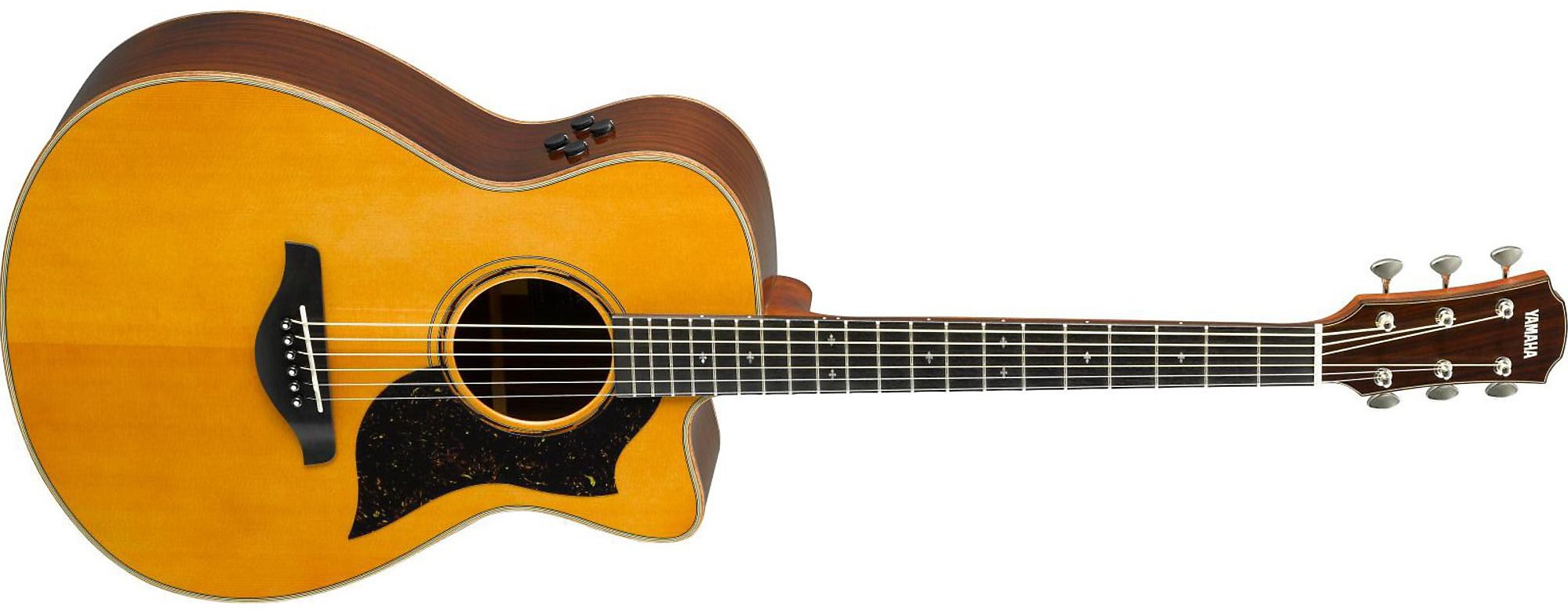
If you’re a guitarist looking for something special, Yamaha’s AC5R ARE Concert Cutaway could be just the instrument for you.
What stands out immediately about this guitar is its Vintage Natural finish – a nod to timeless guitar aesthetics.
But don’t be fooled by its vintage appearance, this instrument is packed with all the modern features you might need.
It is a 6-string acoustic-electrical guitar built with a blend of traditional and modern construction methods.
The top part of the guitar boasts a Solid Sitka Spruce top, well-known for its excellent sound resonance.
This Yamaha guitar also incorporates SRT2 Electronics, marrying traditional and contemporary sound capture.
Its back and sides are crafted from Solid Rosewood, typically used in high-end guitars for its rich, warm tones.
In addition, the guitar’s neck is made of Mahogany, providing excellent durability and superior sound quality.
It’s important to note that the Yamaha AC5R ARE isn’t just about aesthetics and sound – the brand behind this guitar is Yamaha, who have a stellar reputation for quality.
This particular model also features a Rosewood fretboard, a Piezo pickup configuration, and uses Bronze strings, all of which contribute to its unique tonal quality.
Last but not least, this guitar is designed for right-handed players – a significant consideration for any potential buyer.
It might look vintage, but Yamaha’s AC5R ARE concert guitar is a modern instrument packing a serious punch both visually and audibly – a great fit for any passionate guitarist.
- My Review
Upon inspection, the impeccability of the Yamaha AC5R ARE Concert Cutaway immediately stands out.
As an avid guitarist, I find the guitar’s aesthetics to be a solid match for its quality sound, further enhanced by the vintage natural finish.
A pivotal feature is the guitar’s Solid Sitka Spruce Top, which boasts a warm and balanced tone.
What truly differentiates this guitar’s tone from others, you may ask?
It’s the bass, which proves to be more pronounced due to the extra depth of the body.
Furthermore, the solid rosewood back and sides contribute to a rich and resonant sound, which is not overbearing, but just about right for anyone’s musical needs.
One can’t overlook the guitar’s SRT2 electronics, which add to the overall playing quality.
Combined with the piezo pickup configuration, the guitar ensures the sound produced is resonant and amplified without compromise.
That being said, it felt like the guitar’s action was slightly on the high side, which can cause slight difficulty for some players.
Yamaha’s reputation for exacting standards of quality control and customer care shines through in this guitar, despite what might’ve been said.
I found no visible defects like some have suggested in the past.
An issue of possible concern, however, could be that some players might need to seek a luthier’s aid for repairs, but the chances seem low from my personal experience with it.
My impression of the brand remains intact, as Yamaha, in my experience, continues to deliver high-quality instruments, and the AC5R ARE Concert Cutaway is no exception.
Whether you are a professional musician or just someone who likes to strum the strings for fun, the guitar’s performance ticks the right boxes.
However, some musicians might desire a bit more customization despite the playability being high.
In the end, the guitar’s appeal lies in its balance between aesthetics, sound quality, and value for money.
This guitar, albeit its minor concerns, can make a notable addition to any musician’s collection.
- Pros:
- Impeccable craftsmanship and quality.
- Warm balanced tone with bass.
- Punches above its price range.
- Cons:
- Possible production quality issues.
- High action measurements.
- Quality varies across Yamaha range.
My final verdict is that the Yamaha AC5R ARE Concert Cutaway – Vintage Natural provides top-level performance, from its solid Sitka spruce top to the mahogany neck.
Its SRT2 Electronics feature is truly impressive, and the Vintage Natural finish gives it a cool, vintage vibe.
Furthermore, the guitar’s solid rosewood back and sides ensure not just durability, but also contribute to its deep, rich tone.
The Piezo pickup configuration delivers clear, articulate sound, whether played acoustically or plugged in.
This guitar is an excellent choice for any seasoned musician looking for a combination of traditional craftsmanship and modern innovation.
What Factors to Consider When Buying Acoustic Guitars?
When you’re ready to purchase an acoustic guitar, there are several considerations to keep in mind.
Sound quality is often the top priority for musicians, but quality can be subjective.
It’s important to keep in mind that the way a guitar sounds to one person might be slightly different than how it sounds to another, so using your own ears to guide your purchase is key.
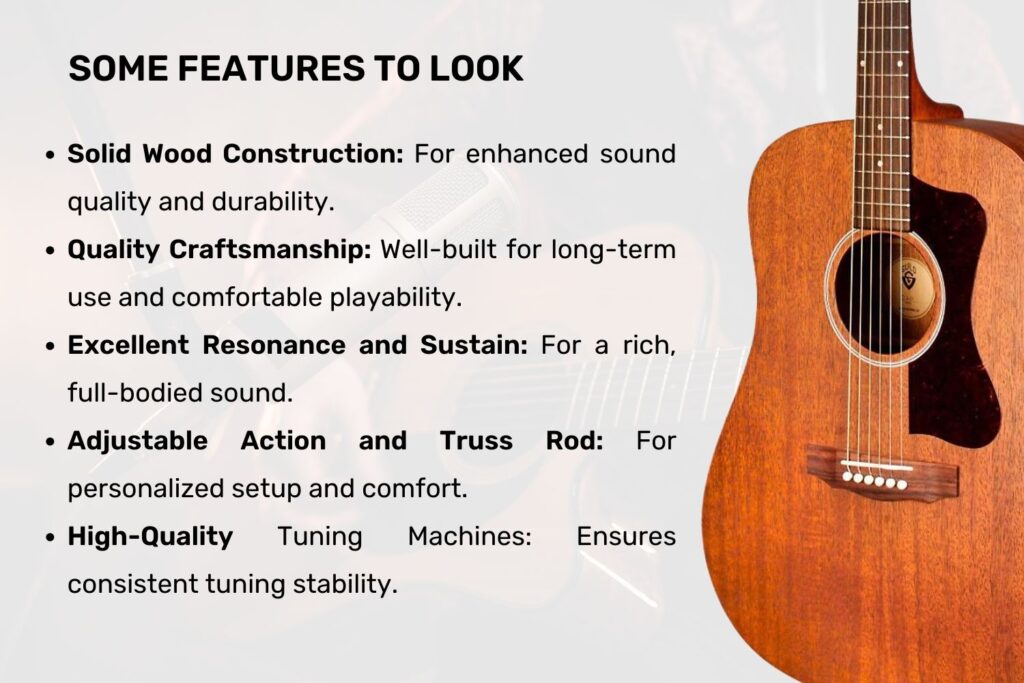
Even two guitars of the same make and model can have small variations in sound, due to differences in the precise shape and thickness of the guitar body and the quality of the wood used in its construction.
A crucial factor to consider is the guitar’s construction.
A well-constructed guitar will be more likely to last, will require less maintenance, and will generally produce a better tone than a poorly built instrument.
For instance, the type of surface treatment a guitar receives can have a significant impact on its sound and durability.
Next is the playability of the guitar,
It’s crucial to choose an instrument that fits comfortably in your hands and is enjoyable to play.
When it comes to playability, factors such as neck width and shape, fretboard material, and string height can all make a significant difference.
The character and style of music you wish to play can also guide your choice.
Certain guitars will lend themselves more naturally to a particular genre of music.
For example, a jumbo or dreadnought-bodied acoustic is often favored by strummers for its strong, driving sound, while fingerstyle players might prefer a smaller-bodied guitar for its increased balance and clarity.
Moreover, you should consider whether you want a guitar with a built-in tuner or pickup system, as these features can be very useful for performing and recording but can also increase the price.
Don’t forget to take the accessories you’ll need into account as well when you’re setting your budget.
A decent case, some picks, a spare set of strings; these items might not seem like much, but they can add up quickly and are necessary for the care and maintenance of your instrument.
Lastly, always make sure to try several different guitars.
Don’t just choose the first one you see or the one that a salesperson recommends.
The more guitars you try, the more you will understand about your own preferences, and the better chance you have of finding the perfect guitar for you.
While this might seem a daunting task, it’s also a lot of fun and very rewarding when you do finally find your perfect match.
Remember, buying a guitar is a personal process, and the key is to try a variety of instruments until you find the one that resonates with you both literally and figuratively.
Does Brand Matter When Purchasing an Acoustic Guitar?
When shopping for an acoustic guitar, many buyers ponder whether the brand of the guitar plays a significant role.
It is an important decision considering the investment involved.
Ranging from well-established brands that have been around for decades to newer entrants in the market, there is a vast selection of guitar manufacturers to choose from.
As a potential buyer, you might find yourself wondering if it’s necessary to opt for an established, renowned brand or if an affordable, lesser-known brand would suffice.
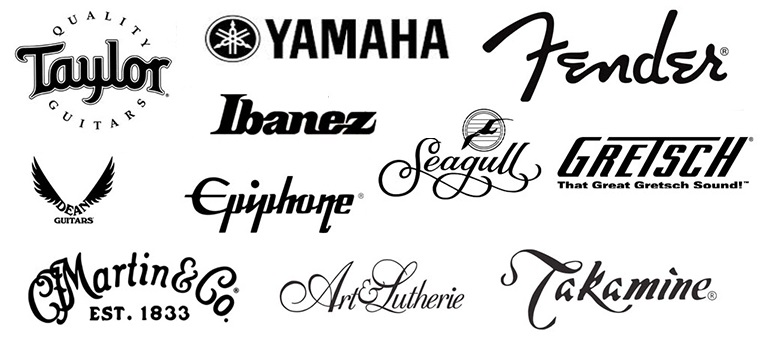
It’s crucial to understand that the brand does matter.
This is not only in terms of quality but also when it comes to the instrument’s resale value.
Ever wonder why certain brands like Martin, Taylor, and Gibson are household names among guitarists?
It’s because they have a consistent track record of delivering top-notch acoustic guitars.
These manufacturers have spent years, sometimes even centuries, perfecting their craft.
Their guitars are often seen as the industry standard, widely used by both amateur and professional musicians alike.
However, this does not mean that you should completely disregard lesser-known brands.
Many newer brands, or those less renowned, are making stellar acoustic guitars that compete with the big players in terms of sound quality, build, and price.
Ultimately, the brand matters as it often reflects the quality, reliability, and resale value of the instrument.
Choosing a famous brand can give you the confidence of the product’s integrity.
You’re less likely to encounter issues related to build quality, sound output, or longevity, all of which are key factors in having an optimal guitar-playing experience.
On the flip side, choosing a less renowned brand could be a gamble, but it may also deliver a wonderful surprise at a lower cost.
The key to choosing the right guitar is to do your research.
Listening to guitar demos, reading customer reviews, and trying out the guitar yourself in-store can help you get a feel of the instrument before making your purchase.
Choosing the right brand for you will also depend on your individual circumstances.
Your choice may be influenced by factors such as your musical style, sound preference, level of expertise, and even budget.
Another important consideration when selecting a brand is the post-purchase support they provide.
Warranty and repair services can save you from unexpected costs further down the line.
More established brands often offer comprehensive warranty programs and reliable repair services, which can bring peace of mind.
Finally, remember that just like anything else, guitars have a “feeling” aspect to them, beyond just the brand name.
How it feels in your hands, how it resonates against your body, and how it responds to your strumming are all important features to consider.
These features can vary from brand to brand, and sometimes even from guitar to guitar within the same brand.
Whether you end up choosing a popular or niche brand, what truly matters is that the guitar fits your needs and preferences.
Your guitar should not just be a musical instrument, but rather an extension of your musical expression.
What Are the Differences in Acoustic Guitar Wood Types?
When selecting an acoustic guitar, the type of wood it’s made from is a critical factor to consider.
The sound, tone, and overall resonance of a guitar are significantly influenced by its wood type.
Strikingly, different types of wood can give different acoustic guitars completely unique sounds and feels.

Hardwoods such as Mahogany and Maple are known for their enhanced durability and ability to project sound with high velocity.
Mahogany wood, in particular, is recognized for a strong mid-range frequency producing a warm, full tone that is perfect for rhythm playing.
On the other hand, Maple is praised for its transparent tone, which means it effectively highlights the sound produced by the strings themselves.
Rosewood is another popular wood choice for acoustic guitars due to its ability to generate a broad range of tones with hefty low ranges and bright trebles.
When used in back and sides, Rosewood can also provide rich overtones which adds depth to the sound.
Moving towards softer woods like spruce and cedar, they are generally used for the guitar top due to their high responsiveness and resonance.
Notably, spruce tops are capable of standing up against vigorous strumming and are able to project the sound adequately.
Cedar, although less durable, responds well to a lighter touch, making it a favourite for fingerstylists.
It’s not just the wood type that matters. Instead, the quality of the wood, its dryness, and how it’s cut influence the guitar’s final sound.
It’s important to remember that laminated woods sound duller compared to their solid counterparts but can offer better resilience to changing weather conditions.
Solid woods, conversely, are more sensitive to humidity but provide a superior sound that improves over time.
Your choice of guitar wood should not just rely on the sound, but also on its durability, resonance, and capability to fit your style of playing.
Lastly, it’s worth noting that your budget will significantly influence your choice of wood types as they vary greatly in cost.
While this may seem overwhelming at first, understanding these differences can guide you to find the perfect guitar that suits your style and budget.
Why Should You Consider the Resonance of Acoustic Guitars?
When discussing the nuances of acoustic guitars, the term resonance often comes up.
Resonance, in the simplest terms, is the quality of the sound that an acoustic guitar produces, influenced by its unique construction and design.
Many factors come together to shape a guitar’s resonance, making it one of the essential features to consider when selecting a guitar.
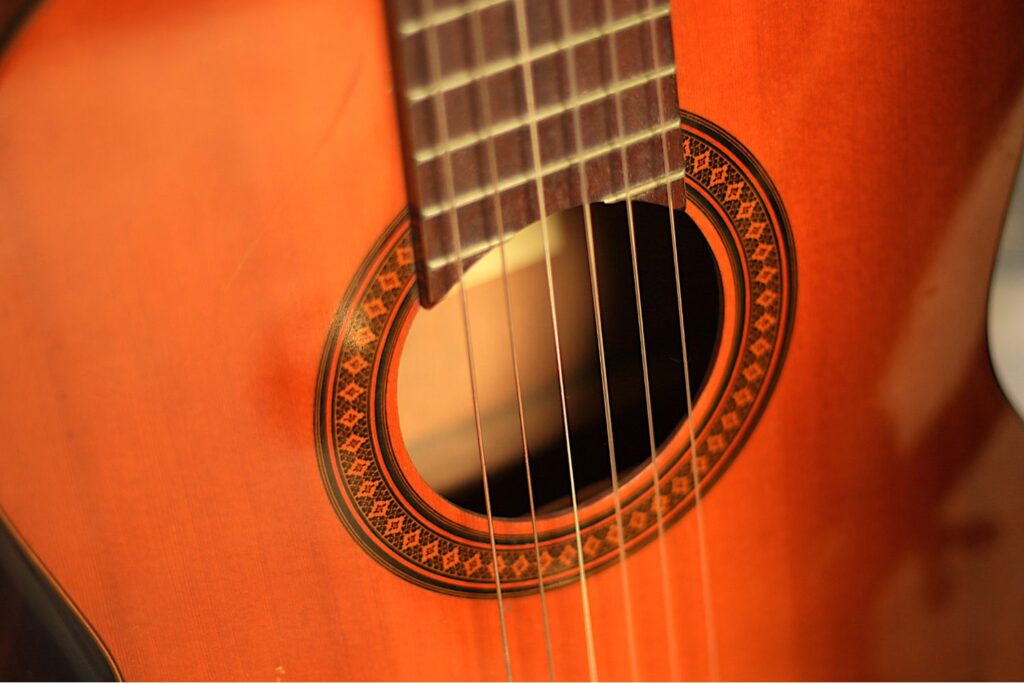
It impacts not only the sound quality but also the instrument’s playability and overall aesthetics.
When you pluck or strum the strings of an acoustic guitar, the vibrations from the strings resonate throughout various parts of the guitar.
These vibrations are then amplified by the guitar’s soundboard, which is typically the top front part of the guitar body, leading to the production of sound.
However, the resonance is not only determined by the soundboard.
It’s also affected by several elements, including the guitar’s body shape and size, the type of wood used, the bracing pattern, and even the finish of the guitar.
Understanding these factors can help you make a more informed decision about the right acoustic guitar for your needs.
For instance, smaller-bodied guitars often produce a more focused sound with a pronounced mid-range, while larger-bodied guitars can achieve a broader sound spectrum, with enhanced bass and volume.
Thus, knowing how the size and shape of a guitar influence resonance can guide you towards an instrument that complements your playing style.
The type of wood or tone-wood used also plays a significant role in a guitar’s resonance.
Each variety of wood can impart different characteristics to the sound of the guitar, with some woods producing bright and sharp tones, and others yielding warm, rich, and full-bodied sounds.
The quality of the bracing pattern, which is placed inside the guitar body to provide support, can significantly influence the guitar’s resonance as well.
A well-designed bracing pattern can compensate for sound diffraction or distortion, helping the guitar produce a more clear and balanced overall sound.
Similarly, the finish on the guitar could also contribute to its overall resonance.
Heavier finishes can dampen the guitar’s sound, while lighter finishes might allow the guitar to vibrate more freely, affecting the overall sound quality.
These are just a few examples of how resonance can drastically shape a guitar’s sound and playability.
It’s thus critical for aspiring guitarists to consider the resonance factor when choosing their instrument.
By understanding how various elements contribute to a guitar’s resonance, you can select a guitar that complements your playing style and delivers the kind of sound you desire.
Whether you’re a beginner learning the ropes or an experienced musician wanting to upgrade your instrument, considering resonance can vastly enhance your overall playing experience.
Does the Neck Shape Affect the Playability of Acoustic Guitars?
When choosing an acoustic guitar, many factors come into play and one of the most overlooked is the neck shape.
It’s essential to understand that not all neck shapes are created equal, and they can significantly affect the playability and tone of the guitar.
The shape of the guitar neck, which can vary across brands and models, will have a substantial impact on your playing comfort and technique.
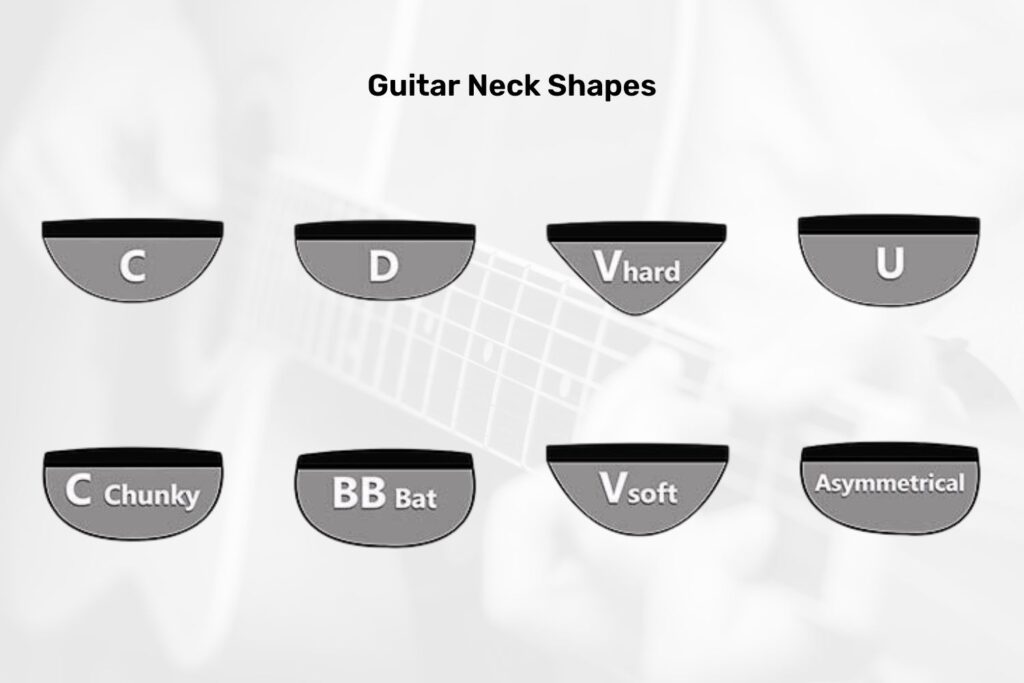
There are three primary types of neck shapes: C, U, and V, each with their unique characteristics and impact on playing.
The C-shaped neck, also known as the modern C, is the most commonly found type and is favored because it caters to a wide variety of hand sizes and playing styles.
On the other end of the spectrum, the U-shaped neck is thicker and suits players who prefer a chunkier feel or play intricate runs and solos.
Mirroring the letter it is named after, the V-shaped neck is quite unusual and can be an acquired taste, with a pronounced feel that enhances grip for some playing styles, particularly the thumb-over technique.
With all these variations in shape, it becomes evident how this factor can significantly influence playability.
For example, having a neck shape that is comfortable for your hand size and caters to your playing style can improve your chord changes and speed your solos up.
On the other hand, an incompatible neck shape can make even the simplest chords hard to play, slowing your progress and possibly causing unnecessary physical strain.
A good way to decide which neck shape suits you best is to, if possible, physically try it out and note your hand comfort and ease of movement before purchasing.
It’s also important to remember that there’s no universal “best” neck shape – what works excellent for one player may be uncomfortable for another, essentially making it a highly personal preference.
In addition to playability, the shape of an acoustic guitar’s neck can also influence the tone of the guitar.
Thicker necks, like the U-shaped one, tend to provide a wider range of overtones and a complex tone, while slender necks serve cleaner, more defined tones.
While a subtle difference, it may matter to experienced players or those with a developed ear for tone.
Finally, it’s important to note that the neck shape can also alter the guitar’s resonance and sustain.
Necks built using a single piece of wood often offer better vibration transfer, leading to improved sustain, a quality often favored by players seeking a fuller, longer-lasting sound from each strum.
The choice of neck shape should also directly relate to the guitar’s overall build where everything must be in harmony to create the desired playability and sound quality.
So, as you can see, while often overlooked, the guitar’s neck shape can have a profound impact on how the acoustic guitar is played and the sound it produces.
Choosing the right neck shape for your individual style and requirements can significantly enhance your playing experience making your music journey more rewarding and enjoyable.
How Does the Guitar Body Shape Affect the Sound Quality?
A guitar’s body shape significantly influences the instrument’s sound quality.
This is primarily due to the function of the guitar body as a resonating chamber.
Contrary to popular belief, sound production in an acoustic guitar does not solely depend on the strings and the guitar’s material.

The shape and size of the guitar body also play a crucial role in forming the instrument’s unique tone.
Consider, for example, larger-bodied guitars such as the dreadnought and jumbo models.
These guitars are known for their powerful projection and rich, full tones.
The reason behind this lies in their larger resonating area, allowing for a comparably louder and fuller sound.
The opposite is true for smaller body shapes such as the concert and parlor guitars.
Since their resonating area is smaller, these guitars produce a sound that is softer with a more focused and balanced response.
It’s not just the volume and depth of tone that are affected by the body shape of the guitar.
The guitar’s body shape also largely determines the projection and sustain of its sound.
For instance, slim, cutaway designs may not have the same volume and sustain as full-bodied guitars, but they do offer improved playability, particularly for the upper frets.
Even the comfort and playability factors are influenced by the shape of the guitar.
A guitar that feels too large or too small can make the playing experience uncomfortable, leading to imprecise and inefficient playing.
It’s crucial, then, to find a body shape that suits your playing style and offers the sound characteristics that you’re after.
Lastly, it’s often overlooked that the guitar’s body shape can dramatically influence its appearance and style.
Whether that’s the elegant curves of an auditorium style or the bold, big-bodied design of a dreadnought, the guitar’s body shape contributes significantly to its aesthetics.
Obviously, while the look of a guitar doesn’t impact its sound, many players understandably have a preference for guitars that sound great and look stunning.
With this in mind, while purchasing an acoustic guitar, it is essential to consider not just the brand, price, and material but also the shape and size of the guitar body, as all of these factors together help to create the unique sound and feel of the instrument.
Therefore, investing time in understanding how different body shapes influence a guitar’s sound can undoubtedly help one in making an informed decision when purchasing a guitar.
To reiterate, the shape of the guitar body has an impressive influence on every aspect of the guitar’s sound – from its tone and projection to its sustain and playability.
An in-depth consideration of these factors can help ensure that the guitar you choose will offer the sound, feel, and look that best suit your unique musical needs and preferences.
Do All Acoustic Guitars Under $2000 Have Inbuilt Tuners?
It is a common question among guitar players whether all acoustic guitars priced under $2000 come equipped with built-in tuners.
It’s important to note that not all guitars, irrespective of their price range, come with inbuilt tuners.
An inbuilt tuner, also known as an onboard tuner, is a handy feature that allows for easier and more precise tuning of the guitar.
In the context of acoustic guitars under the $2000 mark, many do come with integral tuners included.
The higher price point often reflects the inclusion of higher-quality features and components, such as an onboard tuner.
However, this isn’t to say it’s a guaranteed attribute for every guitar in this price bracket.
In fact, when it comes to manufacturers deciding whether to include an onboard tuner, there are multiple factors to consider.
One factor is the type of player the guitar is designed for.
Professional musicians and serious hobbyists might prefer to use their own separate tuner that offers more precision.
On the other hand, beginners or casual players might find an onboard tuner to be more than adequate for their needs.
Another aspect manufacturers consider is the style and design of the guitar.
Traditional, vintage-style acoustic guitars might not include onboard tuners, as they are designed to have a classic aesthetic, free of modern electronic components.
In contrast, more modern acoustic guitars may feature an onboard tuner, along with other electronic components, as part of their design.
Therefore, while many acoustic guitars priced under $2000 do feature onboard tuners, it is not a steadfast rule.
The decision to include an onboard tuner ultimately comes down to the manufacturer, the product’s design, and the targeted guitar player demographic.
As a potential buyer, you should consider what is important to you in a guitar, and whether an onboard tuner is a feature you value.
The presence or absence of an inbuilt tuner does not necessarily reflect the overall quality or value of the guitar.
What matters most is that the guitar suits your individual needs, style, and comfort.
So while an onboard tuner can be a convenient feature, it is not the only factor to consider when investing in a high-quality acoustic guitar.
Ultimately, the search for the perfect guitar is a personal journey that depends on your individual preferences, skill level, and budget.
Therefore, when on the lookout for a new acoustic guitar, remember to research thoroughly, try several models, and above all, choose something that feels right to you.
How to Properly Maintain an Acoustic Guitar?
Maintaining an acoustic guitar is just as crucial as selecting the right one, especially if you want it to serve you for an extended period.
The first and most obvious step in maintaining an acoustic guitar is keeping it clean.
You can clean your guitar by wiping it down after playing, as this helps to remove oils, grime, and dirt that can accumulate over time.
Another key aspect of keeping your guitar clean is cleaning the fingerboard and frets, which usually accumulate the most dirt and grime.
This can be achieved by utilizing professional cleaning tools specifically designed for guitars or a soft, lint-free cloth.
Besides cleaning, changing the strings regularly is another crucial component in maintaining an acoustic guitar.
The frequency of changing your guitar strings depends on how often you play, but as a rule of thumb, professional musicians tend to change them every three months.
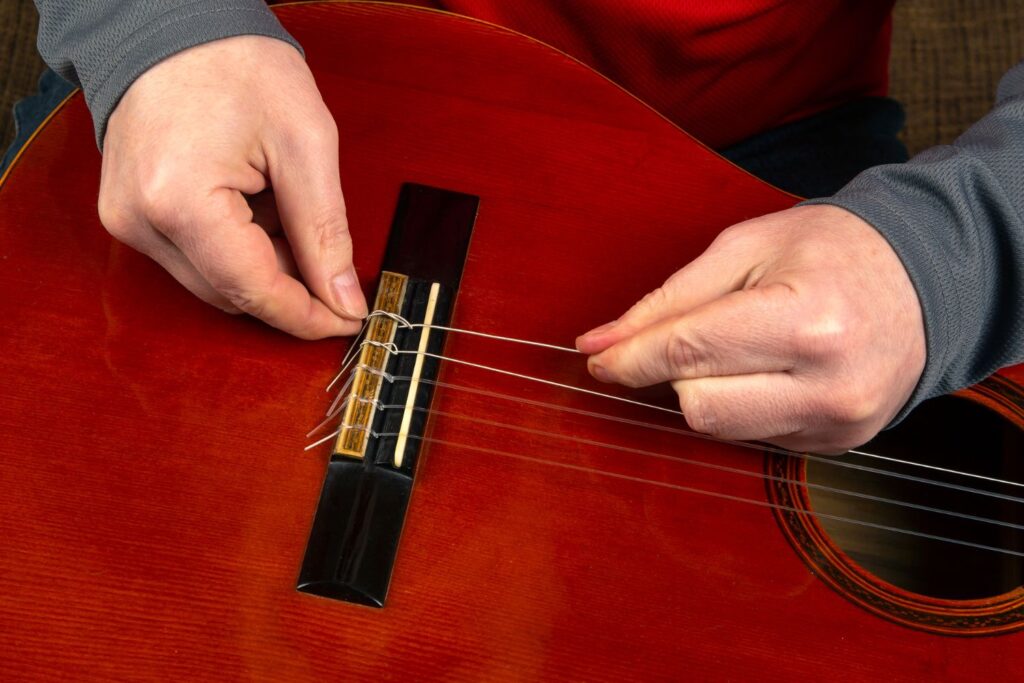
Humidity regulation is another key factor that can significantly affect the longevity and performance of your guitar.
This might sound trivial, but for an instrument made of wood, it’s paramount to maintain the right humidity level, typically between 45 and 55 percent.
You can control humidity levels in your guitar’s storage area with the aid of humidifiers or dehumidifiers, depending on your environment’s condition.
Another factor to keep in mind is the storage of your acoustic guitar.
When not in use, storing your guitar in a hard-shell guitar case can protect it from physical damage, extreme temperatures, and the effects of too much or too little humidity.
In addition, periodic checks and adjustments, commonly known as guitar setups, are necessary to ensure that your guitar is always in top operating condition.
Guitar setups often involve tasks such as adjusting the truss rod to control neck curvature, setting the action (string height above the fretboard), and intonating the guitar to ensure that it plays in tune up the neck.
Professional guitar tech or luthier can help you with these adjustments if you’re not comfortable doing them yourself.
Lastly, always be gentle with your guitar.
Whether you’re playing, cleaning, or storing it, handling your guitar with care will go a long way to keep it in good shape.
Physical damage can occur easily from bumps, knocks, and drops, so treat your guitar with the respect it deserves.
The Bottom Line
So, after examining a range of options, it’s clear there’s a fantastic array of acoustic guitars under $200 overall.
You don’t need to break the bank to access top-quality sound and beautiful craftsmanship.
Whether you are a newcomer to the world of music or a seasoned guitarist wanting a reliable and superior-sounding instrument, there’s something for you listed above.
Regardless of your choice, the dedication to quality and innovation is a common thread among these guitars within the $2000 price range.
Check them out yourself, because only you can find the perfect guitar to make your musical journey worthwhile.
Sources: sweetwater.com ; guitarcenter.com ; killerguitarrigs.com
In love with guitars, and gear; expert in all things music! Been writing about guitars for about 5 years and counting. Born in the ’90s. Alma Mater: University of Havana. Always curious, trying to understand the world. #TeamFender






